

Complete Guide to the Tokyo Imperial Palace: Tour Reservations and the Best Ways to Enjoy Your Visit
The Emperor of Japan, one of the most revered symbols of Japan, resides in the Tokyo Imperial Palace. This is one of the tourist attractions with the largest number of visitors in the world. Built over 400 years ago, the Tokyo Imperial Palace is adorned with flowers all year round, with many natural and green spaces, and there are numerous sights to see within. All these are free for the public to view at their own pleasure, making it a great place to just drop by if you’re ever in the mood for a visit. We’ll walk you through some of these sights in the Tokyo Imperial Palace with photos!
Tokyo Imperial Palace is an oasis in the city
The statue of kusunoki masashige, with his undying loyalty for the emperor, the nijūbashi bridge, which leads to the inner palace, sakurada-mon: the largest existing gate to the tokyo imperial palace, ninomaru gardens, where you can enjoy nature to the fullest, the ruins of the donjon of edo castle, where you can see japan’s largest donjon, the inner palace, which you can visit if you make a reservation prior to visiting, book an unforgettable experience in tokyo.
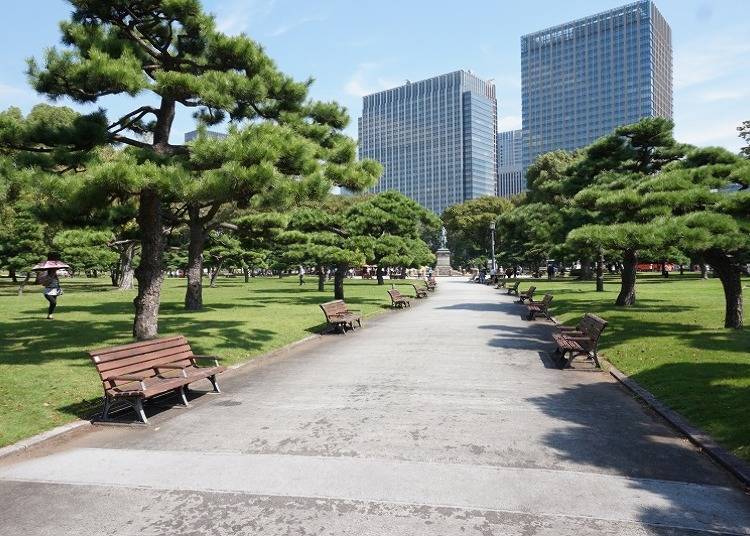
In the Tokyo Imperial Palace, there are three main areas that you can visit, the East Gardens and Outer Gardens , which you can visit for a stroll without any prior reservations, and the Inner Palace, which requires reservations. The palace grounds span approximately 230 hectares (568 acres). Just a 15-minute walk away from Tokyo Station , the vast expanse of greenery and natural landscapes makes it an oasis amidst the towering skyscrapers of the big city. Adorned with a forest of black pine trees and benches along the walking route, the Outer Gardens are an excellent place where you can take breaks while taking for a leisurely stroll. First, we’ll introduce the Outer Gardens , which you can visit for free.
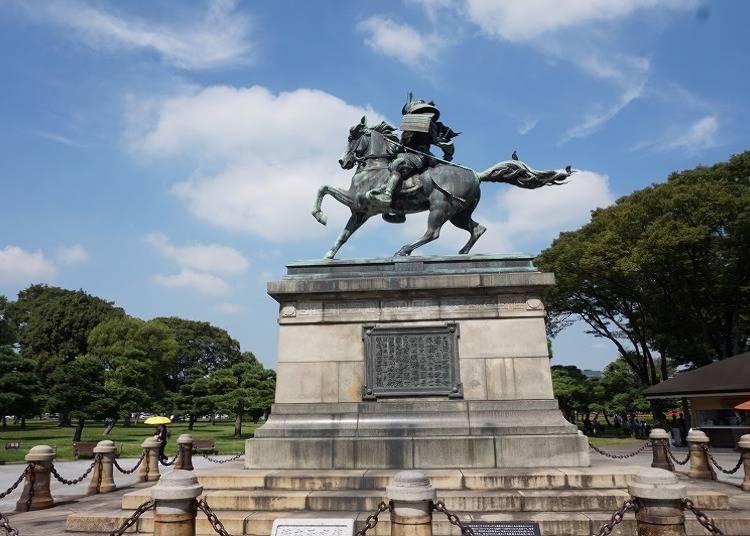
In 1900, the statue of Kusunoki Masashige was erected in the southeastern side of the Outer Palace, and is a popular photo spot, as one of the Three Great Copper Statues of Tokyo. The subject of the statue, Kusunoki Masashige, was a loyal samurai who served the 96th Emperor, Emperor Go-Daigo. He contributed immensely to overthrowing the Kamakura Shogunate, and is a beloved figure of the Japanese. As it is considered impolite for the face of the statue to face the imperial palace directly, one curious trait of the statue is that it faces the opposite direction of the Tokyo Imperial Palace. The lively horse that the figure sits upon is another draw of the statue, and regardless of which angle you look at it, the balance of the sculpture looks equally beautiful.
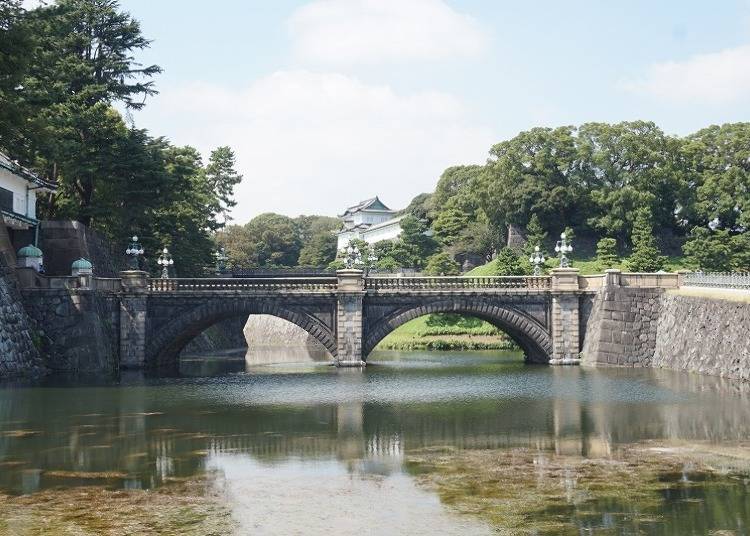
One of the bridges constructed to reach the Inner Palace from the square in front of the Tokyo Imperial Palace is Nijūbashi Bridge, which was constructed in 1614. Renovated in 1888, and once more in 1964, its shape changed to become what it is now. The beautiful castle which you see behind the bridge is Fushimi -yagura, which was moved over from Kyoto in 1628, and the sight of it paired with Nijūbashi Bridge makes for a lovely view. The bridge is usually closed to the public, and only open twice a year, on the Emperor’s birthday and on New Year’s Day, when the public is permitted to enter the Inner Palace, where the Emperor greets the masses.
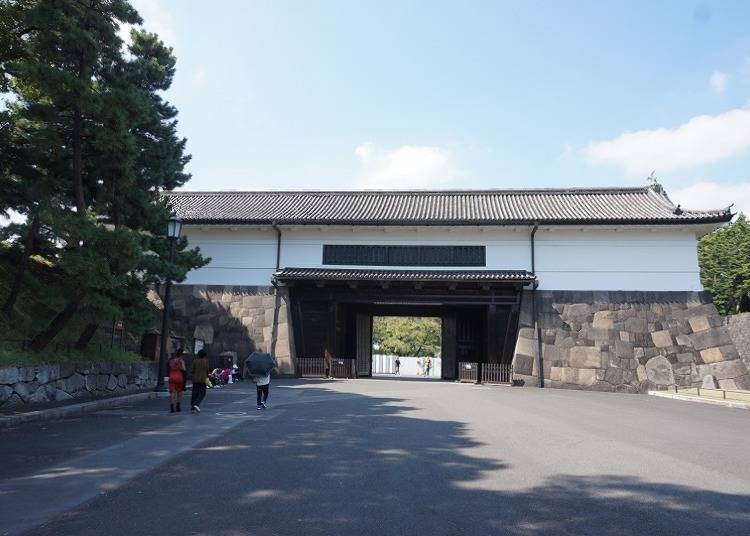
Built in 1612, the Sakurada-mon is the largest surviving gate to the Tokyo Imperial Palace. Destroyed in a fire during the Great Kanto Earthquake of 1923, it was reconstructed into the steel storehouse structure that stands today. The contrast of the finely shaped stone bottom with the white storehouse above is a beautiful sight, and is a popular photo spot for tourists. The double structure of the inner and outer gates allows for a gap in between the two, and it is a great place to see the streets of Tokyo from afar. From the Outer Gardens , we introduced the Kusunoki Masashige statue, the Nijūbashi Bridge, and the Sakurada-mon gate. Next, let’s check out the East Gardens .
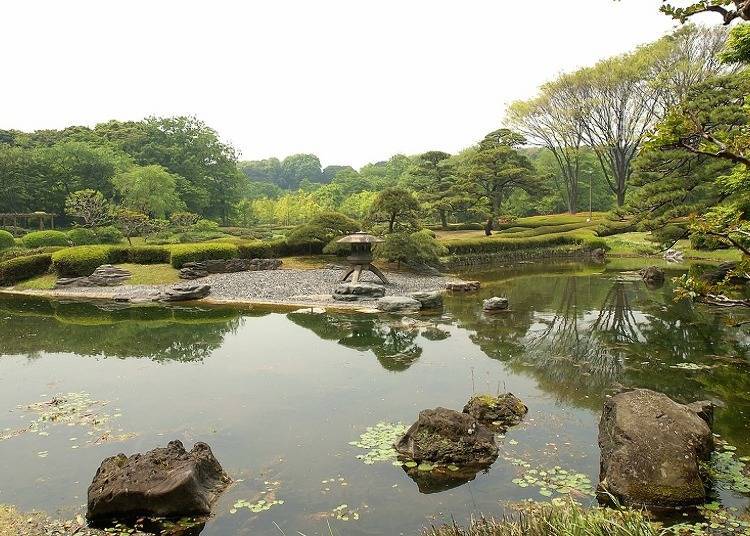
A garden with varied landscapes intended for walks and strolls, it was once the villa of shoguns. At approximately 20 hectares (49 acres), this large garden has plum blossoms in February, azaleas in April and May, irises in June, and maple in Autumn , and you can enjoy the changing scenery all throughout the year. The ponds in the garden are home to fish, turtles, and other small animals, and you can even see the Hirenaganishiki-goi, a breed of koi fish that is highly prized in Japan. Affectionately referred to as the Ninomaru Thicket for its forest -like atmosphere in the middle of the city, it’s a place where you can relax amidst nature .
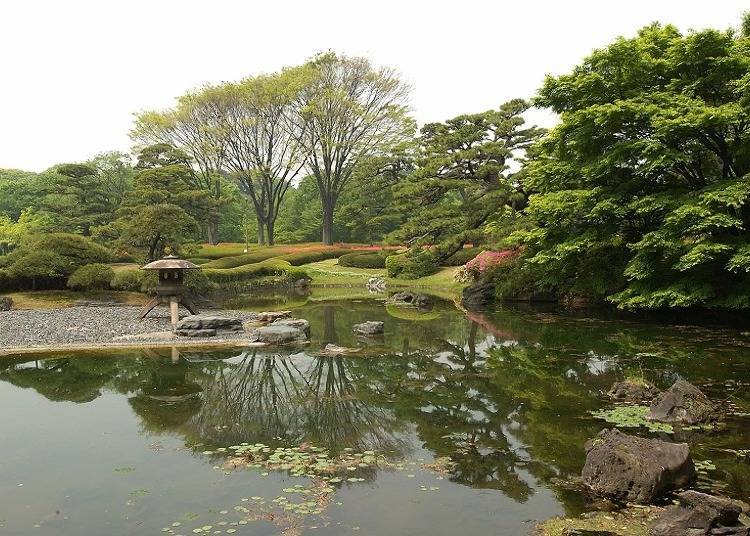
Previously where Edo Castle stood, all that’s left at the Ruins of the Donjon of Edo Castle is its stone foundation. Standing at 11 meters high and 40 meters across on each side, it is a breathtaking sight up close, as the largest donjon in Japan. Destroyed in the Great Fire of Meireki in 1657, all that’s left of the Edo Castle is the stone foundation, which still bears blackened areas and marks from the fire to this day. The area where the castle stood has become an observation deck instead, and a slope was constructed for easier access. From the top of the observation deck, you can catch a 360 degree panoramic view of the nature in the Imperial Palace surrounded by the towering skyscrapers of Tokyo.
If you make a reservation beforehand, it’s possible to tour the Inner Palace. Besides making reservations on the day itself, reservations can be made over the internet as well, and can be done in a variety of languages including English, French, Spanish, Chinese, and Korean, amongst others.
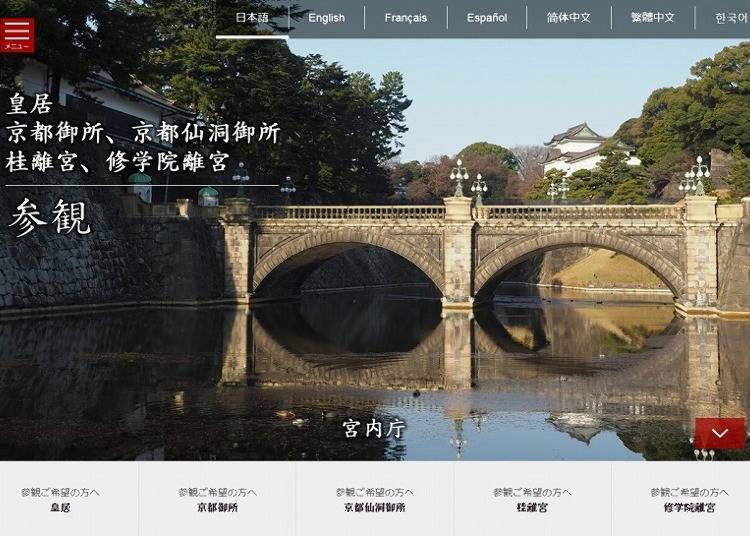
Tours of the Inner Palace happen twice a day, once in the morning at 10:00 a.m., and once in the afternoon at 1:30 p.m. Reservations for the following month can be made starting from the 1st of the previous month, but due to the immense popularity of the tour, it can be quite difficult to get a reservation several days before your visit. Instead, it’s recommended to make your booking as soon as reservations open, on the 1st of the previous month.
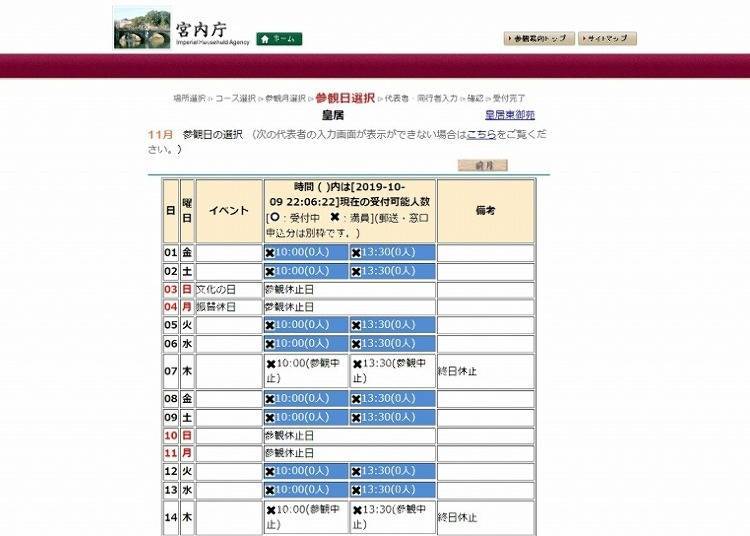
On top of this, personal identification documents such as your passport are needed for entry, so do remember to bring them on the day of your visit. There is a smartphone application, “Imperial Palaces Guide”, available for download. The application provides audio tours, and like the home page, is available in multiple languages, including English, French, Spanish, Chinese, and Korean. It’s recommended that you download the application before the tour itself, and on the day of the tour, you can request for an English speaking guide to bring you around too.
Within the Inner Palace, there are shops too, where you can buy rare souvenirs. From Japanese sake and sweets , to dishware and Japanese wrapping cloths, these souvenirs bear the motif of the chrysanthemum flower, which is the symbol of the Japanese Imperial family. With so many items that are only available for sale here, be sure to check out the souvenir shop . Do be aware that you’ll only have a chance to buy souvenirs before the tour starts, so take note! During the tour, you’ll get to see the Imperial Household Agency up close, which is a government agency responsible for handling matters related to the Imperial Family, as well as the Emperor’s residence within the Tokyo Imperial Palace. Do grab this chance to solemnly experience Japanese culture in this historic building. One of the draws of the Tokyo Imperial Palace is the different ways you can experience it, from a leisurely stroll through the East Gardens and Outer Gardens , to the tour of the Inner Palace where you can view the chambers of the Emperor himself. We introduced numerous places of interest within the Imperial Palace, and if you have opportunity, be sure to check them out!
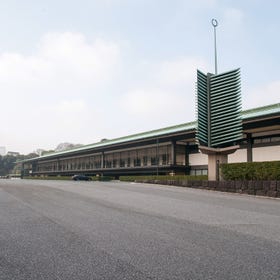
- Address 1-1, Chiyoda, Chiyoda-ku, Tokyo, 100-8111 View Map
- Nearest Station Nijubashimae "Marunouchi" Station (Tokyo Metro Chiyoda Line) 10 minutes on foot
- Phone Number 03-3213-1111
Make your trip extra memorable by booking one of these recommended tours.
- Area Tokyo Station
Share this article.
Limited time offer: 10% discount coupons available now!
Recommended places for you.
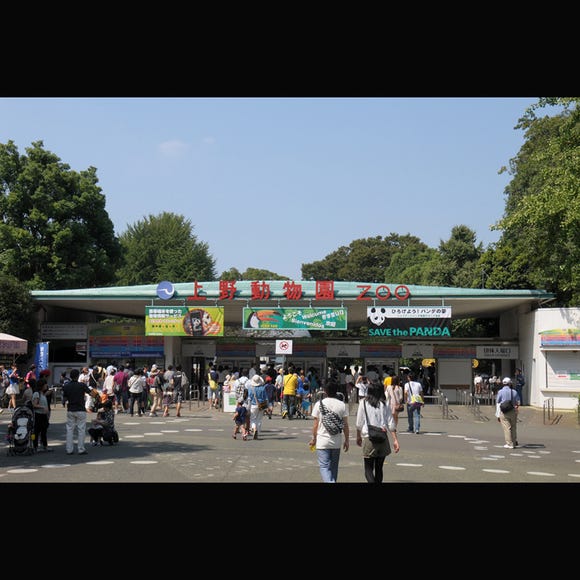
Ueno Zoo (Ueno Zoological Gardens)
Zoos, Aquariums & Botanical Gardens

The Tokyo Station Marunouchi Building
Tokyo Station

Kappabashi Street
Old Towns (Shitamachi)

Nezu Shrine

Tokyo Tower

Tokyo Metropolitan Government

Everything You Need To Know About the Kyoto-Osaka Sightseeing Pass

Complete Guide to the JR Hokuriku Arch Pass: Your Key to Kanazawa, Fukui, and Japan's Coastal Wonders

Tokyo Summer 2024: Snooze with Snorlax in a Pokémon Sleep Suite!

Opened in Spring 2024! What to do at Tokyu Plaza Harajuku Harakado

The Complete Guide to the Kintetsu Rail Pass

A Complete Guide to the JR West Kansai Area Pass
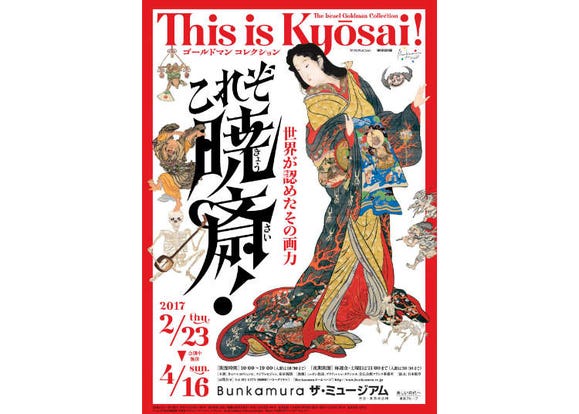
Tokyo's Top 5 Art Exhibitions in March and April to Celebrate Spring
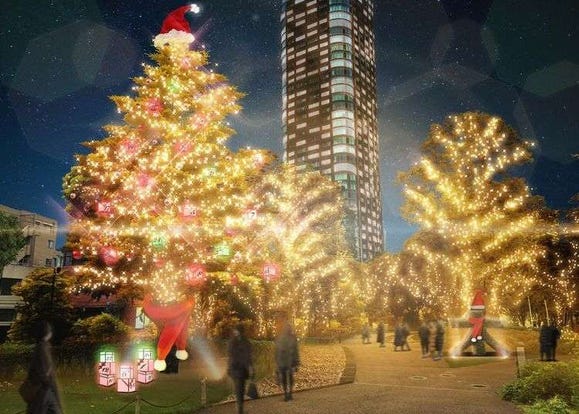
7 Best Winter Events in Tokyo: Chilly Evenings, Shiny Holidays (November/December)
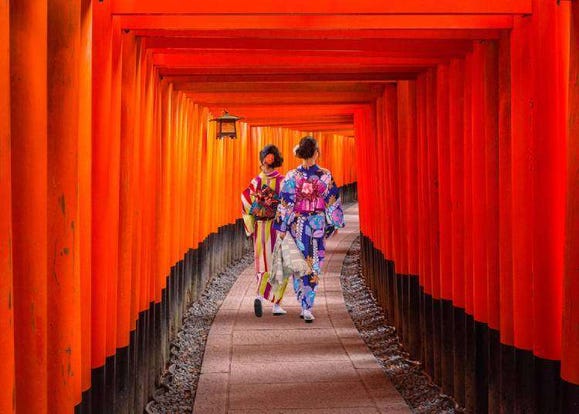
10 Major Cities in Japan: Which One Should Top Your Bucket List?
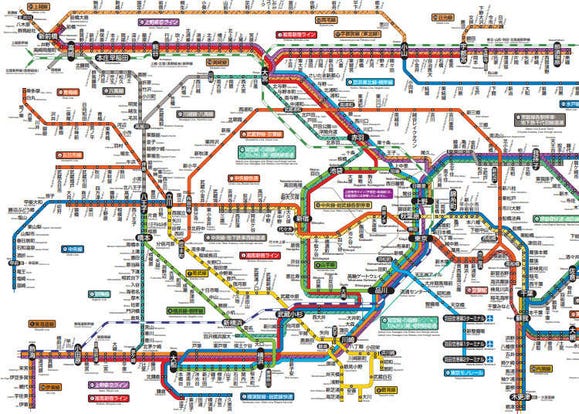
Tokyo Train Map: The Complete Guide to Tokyo Subways & Railways
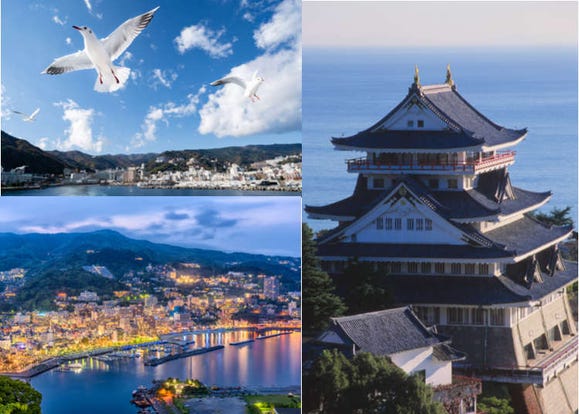
Atami 1-Day Itinerary: Exploring Japan's Castle & Hot Springs Resort Town Near Tokyo!
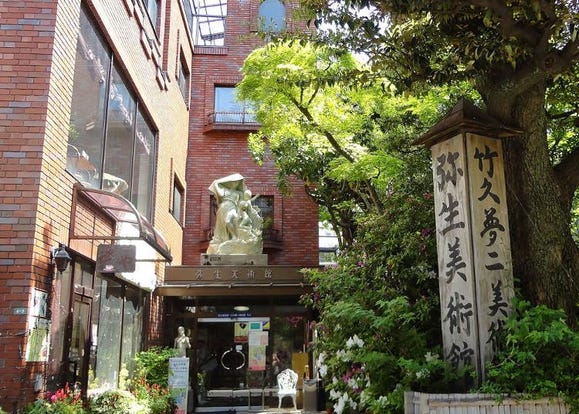
Exploring the Masterpieces: Popular Art Museums in Ueno
- #best ramen tokyo
- #what to buy in ameyoko
- #what to bring to japan
- #new years in tokyo
- #best izakaya shinjuku
- #things to do tokyo
- #japanese nail trends
- #what to do in odaiba
- #onsen tattoo friendly tokyo
- #best sushi ginza
- #japanese convenience store snacks
- #best yakiniku shibuya
- #japanese fashion culture
- #best japanese soft drinks
- Media & Industry
- Meetings & Events
- Select Language 简体中文 繁體中文(香港) 繁體中文(臺灣) India (English) Bahasa Indonesia 한국어 ภาษาไทย Tiếng Việt Singapore (English) Philippines (English) Malaysia (English) Australia/New Zealand (English) Français Deutsch Italiano Español United Kingdom (English) Nordic countries(English) Canada (English) Canada (Français) United States (English) Mexico (español) Português العربية Japan(日本語) Global (English)
- India (English)
- Bahasa Indonesia
- Singapore (English)
- Philippines (English)
- Malaysia (English)
- Australia/New Zealand (English)
- United Kingdom (English)
- Nordic countries(English)
- Canada (English)
- Canada (Français)
- United States (English)
- Mexico (español)
- Global (English)
- Fujiyoshida
- Shimonoseki
- Ishigaki Island
- Miyako Island
- Kerama Island
- Tokyo Island
- Koka & Shigaraki
- Hida Takayama
- Ginza, Nihonbashi
- Beppu & Yufuin (Onsen)
- Ginzan Onsen
- Nagasaki Islands

- Kumano Kodo
- Shikoku Karst
- Amami Oshima
- Hachimantai
- Omihachiman
- Aizuwakamatsu

- Diving in Japan
- Skiing in Japan
- Seasonal Flowers in Japan
- Sustainable Outdoors
- Off the Beaten Track in Japan
- Scenic Spots
- World Heritage
- Home Stays & Farm Stays

- Japanese Gardens
- Japanese Crafts
- Temple Stays
- Heritage Stays
- Festivals and Events
- Theater in Japan
- Japanese Tea Ceremony
- Cultural Experiences in Japan
- Culture in Japan

- Local Cuisine Eastern Japan
- Local Cuisine Western Japan
- Local Street Food
- Japan's Local Ekiben
- Japanese Whisky
- Vegetarian and Vegan Guide
- Sushi in Japan Guide
- Japanese Sake Breweries

- Art Museums
- Architecture
- Performing Arts
- Art Festivals
- Japanese Anime and Comics
- Japanese Ceramics
- Local Crafts

- Scenic Night Views
- Natural Wonders
- Theme Parks
- Samurai & Ninja
- Iconic Architecture

- Wellness Travel in Japan
- Japanese Ryokan Guide
- A Guide to Stargazing in Japan
- Relaxation in Japan
- Forest Bathing (Shinrin-yoku)

- Experiences in Japan
- Enjoy my Japan
- National Parks
- Japan's Local Treasures
- Japan Heritage
- Snow Like No Other
- Wonder Around Japan

- Visa Information
- Getting to Japan
- Airport Access
- COVID-19: Practical Information for Traveling to Japan
- Anime Tourism
- Countryside Stays
- Accessible Tourism
- Hokkaido Great Outdoors
- Scenic World Heritage in Tohoku
- Shikoku’s Nature and Traditions
- Southern Kyushu by Rail

- Traveling by Rail
- How to Travel by Train and Bus
- JR Rail Passes
- Scenic Railways
- Renting a Car
- Sustainable Travel in Japan
- Travel Brochures
- Useful Apps
- Online Reservation Sites
- Eco-friendly Accommodation
- Luxury Accommodations
- Traveling With a Disability
- Hands-free Travel
- How to Book a Certified Tour Guide
- Volunteer Guides
- Tourist Information Center

- Japanese Manners
- Spring in Japan
- Summer in Japan
- Autumn in Japan
- Winter in Japan
- Cherry Blossom Forecast
- Autumn Leaves Forecast

- Japan Visitor Hotline
- Travel Insurance in Japan
- Japan Safe Travel Information
- Accessibility in Japan
- Vegetarian Guide
- Muslim Travelers
- Safety Tips

- JAPAN Monthly Web Magazine
- Arts & Cultures
- Nature & Outdoor
- Festivals & Events
- Insider Blog
- Things to do
- Local Guides
- Food & drink
- Traditional
- Hokuriku Shinetsu

My Favorites
${v.desc | trunc(25)}
Planning a Trip to Japan?
Share your travel photos with us by hashtagging your images with #visitjapanjp
- Imperial Palace & Tokyo Station
- Imperial Palace
Imperial Palace 皇居
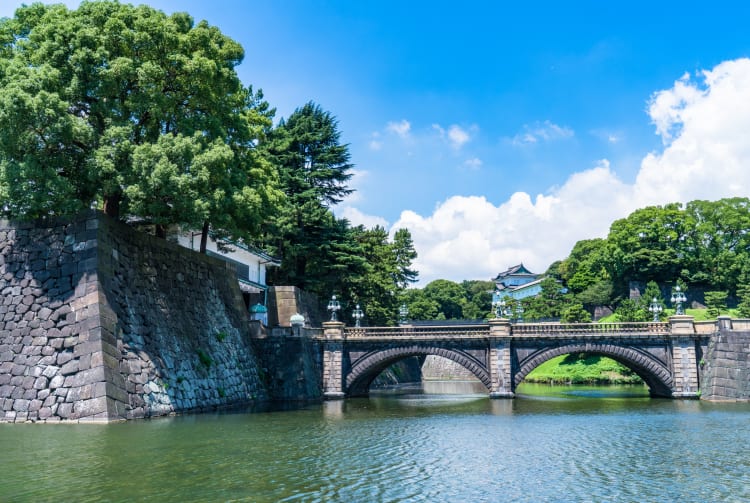
1-1 Chiyoda, Chiyoda-ku, Tokyo-to
- View on Google Maps
- Get Transit Info
Visit the home of Japan's Imperial family
Tucked away behind moats and thick stone walls, the residence and offices of the Emperor of Japan occupy an enviable spot in central Tokyo.
Quick Facts
The Imperial Palace moved to Tokyo in 1868
Tours of the palace run daily at 10 a.m. and 1:30 p.m, and take approximately 1 hour.
How to Get There
The palace is located in central Tokyo and is easily accessible from Nijubashimae Station or Otemachi Station.
Visitors who wish to see the entrance to the palace should head towards the Sakashita-mon Gate, which is a 15-minute walk from Nijubashimae Station or Otemachi Station. You can also walk there from Tokyo Station's Marunouchi exit in 20 minutes.
If you plan on joining the Imperial Palace tour, meet your guide at the Kikyomon Gate, a 10-minute walk from Nijubashimae Station or Otemachi Station.
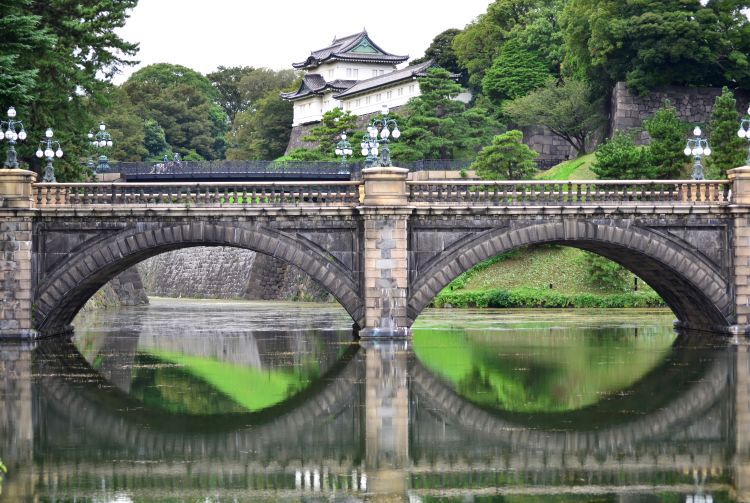
The center of the new capital
For around 1000 years Kyoto was the capital of Japan, but in 1868 both the capital and Imperial Palace were moved to Tokyo after the Meiji Restoration. This has been the home of the Emperor and his family ever since.
See beyond the gates
Arranging for a tour.
Tours run twice each day except on Sundays, Mondays and public holidays. Reservations are recommended, and can be made through the Imperial Household Agency's website (note: visits and advance applications have been temporarily suspended to prevent the spread of new coronavirus infection. Check the website for more information). Although the tours are usually offered in Japanese only, apps in six languages are also available. Highlights of the tour include the chance to see the Kyuden, or main palace, and the Fujimi-yagura watchtower.
Visit during the Imperial family's New Year's greeting
If you're planning a winter trip to Tokyo, be at the palace on January 2 for the New Year's greeting. On that special occasion, the palace gates are opened to visitors who can come in and marvel at the inner palace grounds and see the Imperial family greeting their subjects.
* The information on this page may be subject to change due to COVID-19.
Recommended for You

Please Choose Your Language
Browse the JNTO site in one of multiple languages
In order to view this website correctly, you will need to have JavaScript enabled in your browser.
Skip to main content.
- Travel Trade & Press
- School Trips
- Business Events
GO TOKYO The Official Tokyo Travel Guide
New & Now
Tokyo Area Guide
Things to Do
Plan Your Trip
- Choose Language 日本語 ENGLISH 中文(简体) 中文(繁體/正體) 한글 ภาษาไทย DEUTSCH ITALIANO ESPAÑOL FRANÇAIS
Share this page
- X (Twitter)
- My Favorites
- All New & Now options
- New & Trending
- Spring Guide
- Summer Guide
- Autumn Guide
- Winter Guide
- Places The Locals Go
Stories & Guides
- Another Tokyo
- All Things to Do
- Attractions
- Food & Drink
- Onsen & Bathhouses
- Art & Design
- Anime & Manga
- Time Trip Tokyo
- Walks & Tours
- Tokyo Event Calendar
- All Tips to Plan Your Trip
- Accommodations
- Getting to Tokyo
- Getting Around
- Airport & Cruise Terminal Access
- Customs & Manners
- Weather & Geography
- Visa & Immigration
- Tokyo at a Discount
- Tours of Tokyo
- TOKYO Brochures
- PDF Maps & Guides
- Tourist Information Centers
- Online Tourist Guide
My Tokyo Guide
See something interesting? Click on the heart button in the article to add a page from this site to My Favorites.
Popular Keywords
- Guide Service
Advanced Search
- From open calendar
- To open calendar
- All Stories & Guides
Select Language
- ESPAÑOL
- FRANÇAIS

- A guide to the Tokyo Imperial Palace: history & how to tour
Main content starts here.
Updated: October 28, 2020
Tokyo Imperial Palace and its beautiful gardens are a world away from the hustle bustle of the city. Just a 10-minute walk from Tokyo Station and the high-rise Marunouchi financial district, this calm green oasis covers an impressive 1.15 square kilometres in the central Chiyoda Ward. Built on the site of the former Edo Castle, the palace became the permanent home of the Imperial Family in 1869. While you can’t go inside, except on rare special occasions that let you glimpse the interior, the surrounding manicured lawns, topiary trees and meticulously maintained gardens are not only visually enchanting but give a good idea of what being royalty is all about.
Edo Castle turned Imperial Palace
For over 250 years, Japan was ruled by the Tokugawa shogun during what was known as the Edo Period – Edo being the old name for Tokyo. The current Imperial Palace, known as Kokyo in Japanese, sits on the former site of Edo Castle. However, in 1868, the shogunate was overthrown, and Japan’s capital was moved from Kyoto to Tokyo, with the Imperial Residence moving with it. The palace was destroyed during the Second World War but rebuilt in a similar style afterwards.
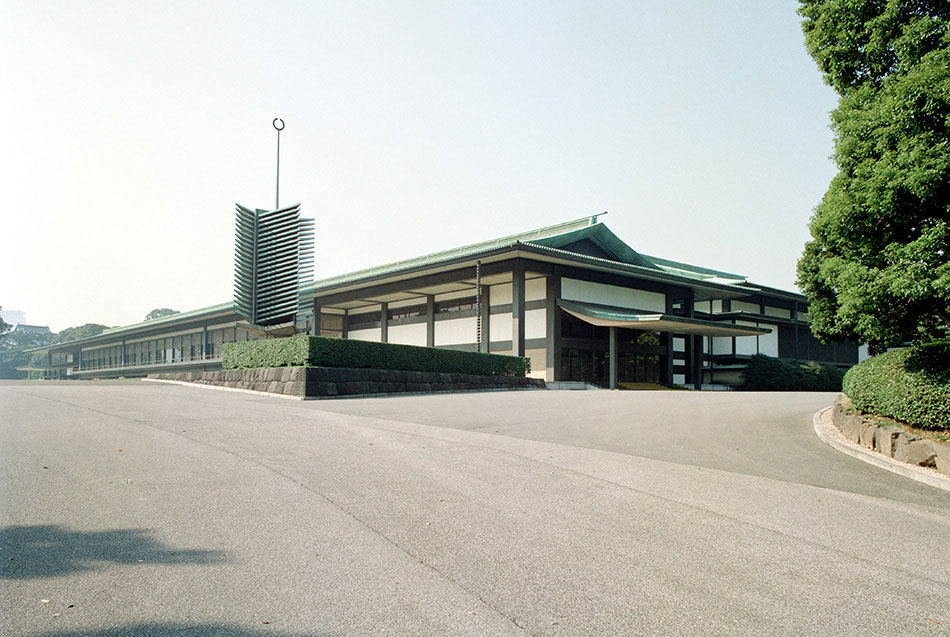
Copyright Imperial Household Agency of Japan
Visiting the Tokyo Imperial Palace
You can call by the site of the Imperial Palace any time –its perimeter is a popular jogging route and the East Gardens are open to the public year-round. However, to make the most of your visit and get a good historical overview, put on some comfortable shoes and take a walking tour.
Check the Imperial Palace’s official website for a map of the grounds.
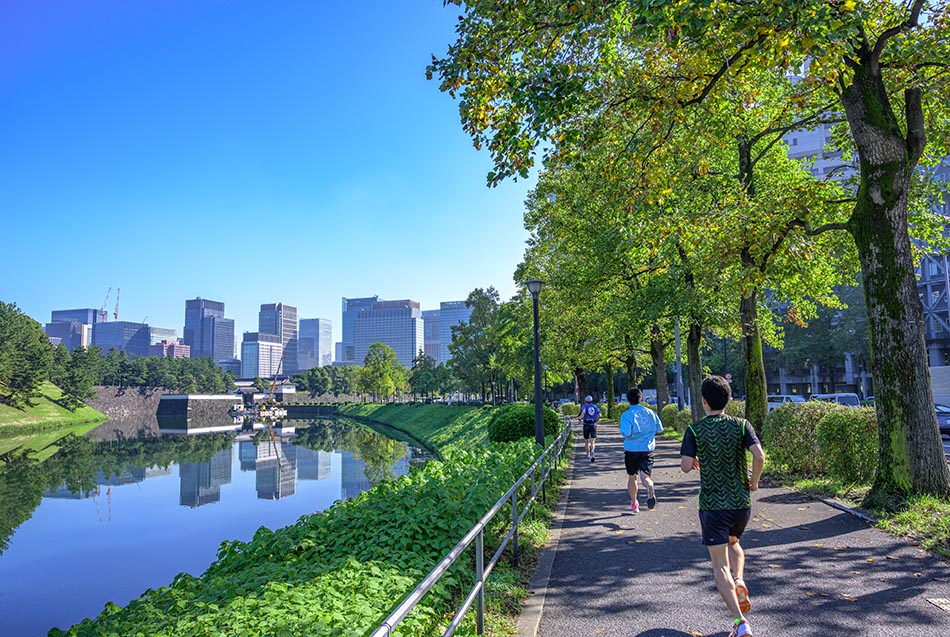
Imperial Palace Walking Tour
Some part of the inner palace grounds can only be viewed on a tour, which is held in English and Japanese, twice daily, Tuesday thru Saturday. While same-day tickets are available, you can easily skip the queues by making an advance reservation for a ticket through contacting the Imperial Household Agency. The tour is open and distributed from 9:00 for the morning tour starting at 10:00, and 12:30 for the afternoon tour starting at 13:30. The 75-minute tour meets at Kikyomon Gate. Although it won’t take you inside the palace, you will get the chance to see historical and beautiful sites such as the Mt. Fuji-view Keep and the Lotus Moat, and, of course, you will cross over the famous Nijyu Bridge, considered a symbol of the palace and even Tokyo itself.
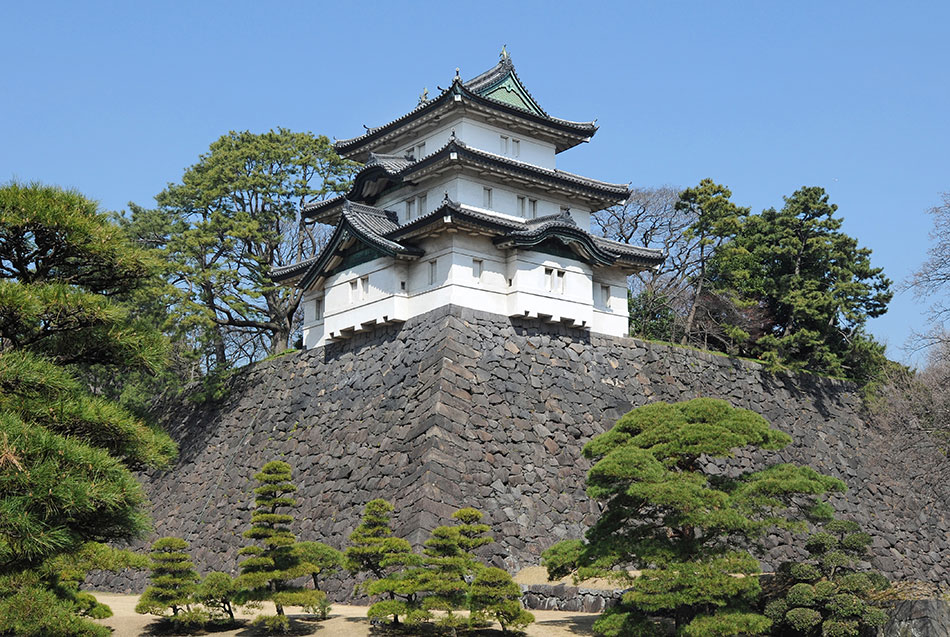
East gardens
Open daily except Mondays, Fridays and designated holidays, these beautiful Japanese gardens are free to the public and especially popular for their dazzling cherry blossoms during the spring and their vibrant autumn foliage later in the year. Take a stroll for a glimpse into the area’s history as the former site of Edo Castle-you can view and climb the foundation of a castle tower that burned down over 350 years ago. Also stop by the Museum of the Imperial Collections.
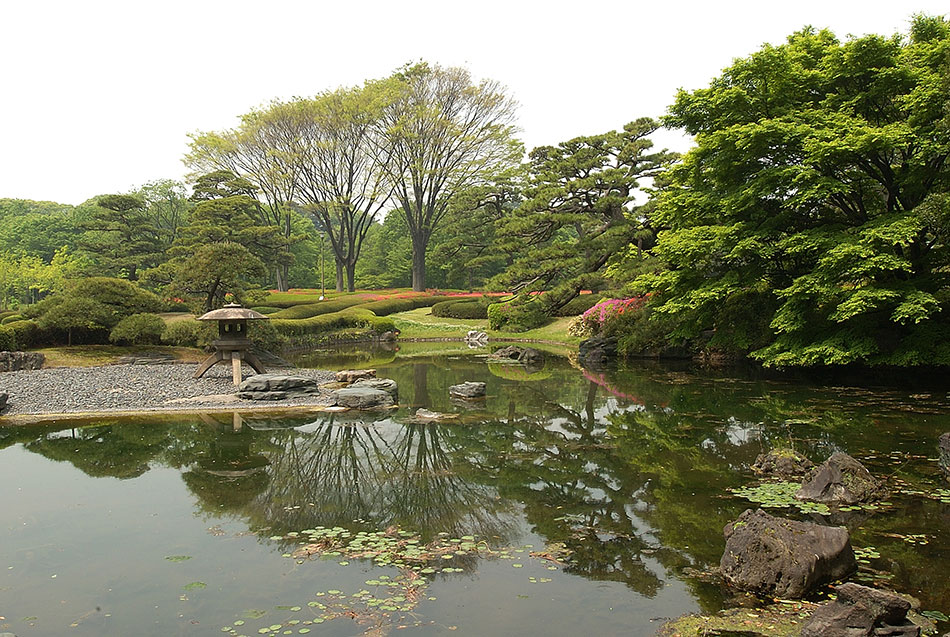
"Ippan Sanga"- Seeing the Imperial Family
Since the Imperial Palace is the main residence of the Imperial Family, it is fairly understandable that they can’t welcome visitors all year round. But there are two days a year when you catch a glimpse of them up close. As part of a New Year celebration , on January 2nd, the grounds of the Imperial Palace are open to the general public. Large crowds gather in the square in front of the Chowaden Reception Hall where the Imperial Family make five scheduled public appearances from morning to early afternoon. Due to the large crowds, leave your bags behind and wear comfortable shoes. It may take more than two hours to get to the Main Gate from the Front Plaza of the Imperial Palace due to a large turnout so make sure to arrive well in advance.
The other opportunity to get up close to the Imperial Palace is on the date of the current Emperor’s birthday-February 23rd. The Imperial Family will make three appearances and you can also sign the Greeting Book.
Hotels near the Imperial Palace
Sitting truly in the heart of Tokyo and with great access to the city, there are plenty of hotels around the Imperial Palace. Imperial Hotel Tokyo is a luxurious hotel that has won 5 stars on the hotel information website "five Star Alliance". It opened in 1890 in order to accommodate an influx of distinguished international visitors.
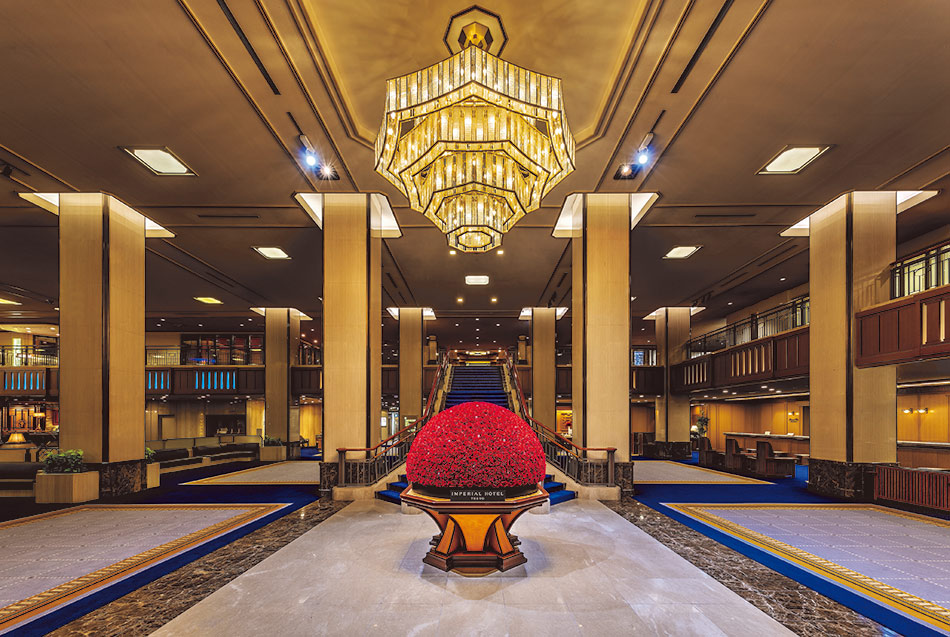
The Forbes Travel Guide five-star Palace Hotel Tokyo is also known for its perspective on the city and a singular, moat-side setting just opposite the Imperial Palace gardens.
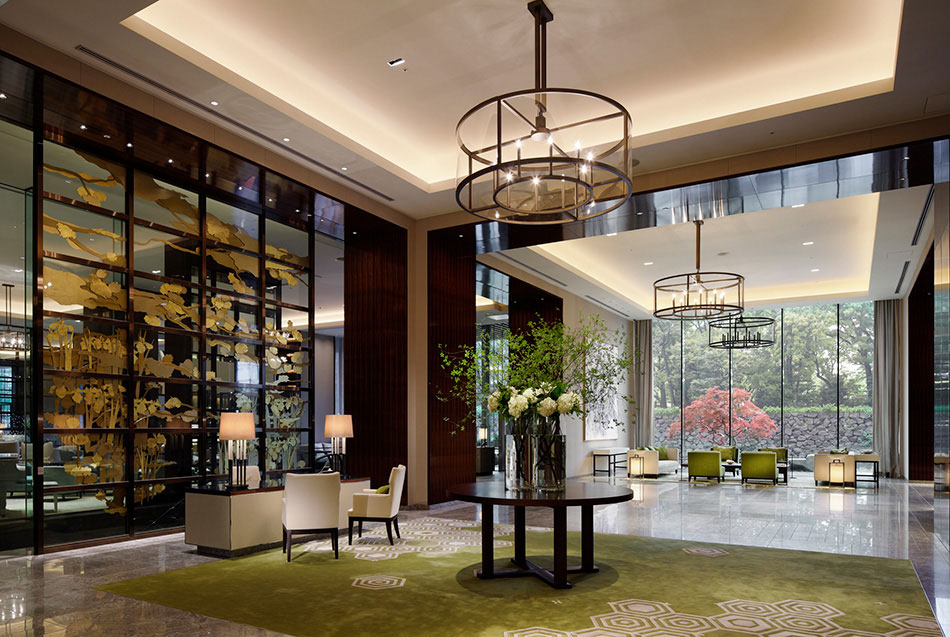
For more mid-range and budget accommodation, take a look in the Hanzomon area on the western edge of the palace grounds or around Kudanshita to the north.
Find Out More
- Experiences & Activities
- Historical Sites
- Parks & Gardens
- Visit Tokyo >
- Tokyo Area Guide >
- Central Tokyo >
- Tokyo Station & Marunouchi area travel guide >
- About This Site
- Font Size and Color
Copyright © Tokyo Convention & Visitors Bureau. All rights reserved.
tsunagu Japan Travel
tsunagu Japan Travel site
- Tokyo's Imperial Palace & Nihonbashi Tour
Photo Credit: Viator
This tour will take you around the Imperial Palace in Tokyo, a deeply historical site once home to Edo Castle, and where the Emperor and Empress of Japan reside today. It then moves onto nearby Nihonbashi, a bustling commercial district with stores that have been in business for over 400 years.
- More Details
Why We Recommend This
- Explore the grounds of Tokyo's Imperial Palace, including the beautiful East Gardens and ruins of Edo Castle, with a knowledgeable English-speaking guide.
- Learn about the Imperial Palace’s highlights, such as the Nijubashi Bridge, and the many seasonal plants and flowers that adorn its gardens.
- Follow it up with a tour of Nihonbashi, one of Tokyo’s biggest and oldest commercial districts.
- Visit a variety of long-established stores, and taste their specialties like dashi soup stock, sake, and seaweed. You can also try knife sharpening and craft your own sheet of Japanese “washi” paper.
- Gain a deeper knowledge of the old Tokyo that still lies beneath its modern facade.
This post may contain affiliate links. If you buy through them, we may earn a commission at no additional cost to you.
1-9, Marunouchi, Chiyoda-ku, Tokyo
Related Articles
Visiting katsura imperial villa and tea ceremony experience, osaka local foodie walking tour in dotonbori and shinsekai, maizuru full-day private tour with government-licensed guide, osaka city boat cruise and amanohashidate gondola trip, latest contents, show tickets at non-verbal theatre gear, [30minutes] asakusa/tokyo skytree+tokyo city central tour, [90 min] tokaido tour: tokyo to mt. fuji helicopter tour.
- Transportation
- Tokyo Cheapo (繁體中文)
Tokyo Imperial Palace Mega Guide
Just ten minutes from Tokyo Station lies Tokyo Imperial Palace: a wealth of gardens and galleries, with guided tours and castle ruins.
Pro tip: Make the most of your visit to the area by joining this walking tour . Not only will you visit the Imperial Palace, but you’ll also get to taste some sake, try your hand at knife sharpening, and learn about traditional Japanese food like dashi (soup stock) and seaweed.
Like an island of respite, the Tokyo Imperial Palace is surrounded by parks and gardens offering a getaway from the busy city streets. Surrounding the home of the Emperor, the grounds are painstakingly maintained and are one of the top destinations for visitors to the capital.
Covering 1.3 square miles, the grounds include hanami (cherry blossom viewing) spots, art galleries, historical ruins and beautiful gardens—plus a private section reserved for royalty, of course. Once the site of Edo Castle, the land is now among the most highly valued in Japan, and is a short walk from Tokyo Station .
If you’re planning to visit, there are organized tours of inner areas available for free, as well as special days when you can see the Emperor himself—so read on and learn all you need to know about Tokyo Imperial Palace and the treasures it holds!
Pro tip: Book a private guided tour to get the most out of your visit to the Imperial Palace in Tokyo.
The History of Tokyo’s Imperial Palace

The current palace grounds were the site of Edo Castle, and before that, the residence of warrior Edo Shigetsugu. The land was close to Hibiya , which was then a beach, and was a strong flatlands location, strengthened by moats. Built in 1457 by Ota Dokan, Edo Castle (also known as Chiyoda Castle) was an important location in the development of Japan. During the Siege of Edo, it was taken over by the Hojo clan, and was later abandoned during the Siege of Odawara in 1590. The castle later became the base of Tokugawa Ieyasu and the Tokugawa Shogunate was formed there, with the castle becoming the military capital. Read more about the history of Tokyo . If you want some more of Edo-era Tokyo then heck out these old-school corners of Tokyo or these unusual theme parks in Japan .
Following the Meiji Restoration it became the Imperial Palace, with Emperor Meiji residing there until the new palace was built. Unfortunately, like many old Japanese structures, almost nothing remains of the original castle or ancient buildings today following fires, earthquakes and war damage—but a few small areas have survived. The Tenshudai (pictured above) is the foundation of the once-tallest tower in Japan, and can be found in the East Gardens.
Tokyo Imperial Palace grounds and gardens
Although the inner grounds are off-limits for the majority of the year, visitors are still able to explore the parks and gardens free of charge and without registration. The area is divided into three main sections: the East Gardens, Kitanomaru Koen Park and the Kokyo Gaien National Garden—all surrounded by a great jogging route for those who would like more than a stroll.
The East Gardens

Opened to the public in 1968, the East Gardens are located in the innermost circles of Edo Castle: the Honmaru and Ninomaru . The former was the principal complex where the rulers spent their daily lives, the latter was where meetings would take place with visiting feudal lords. The two areas combined form one of the last Edo Gardens to be preserved in Japan, and are filled with carefully-maintained seasonal flowers and trees. The Honmaru is a large lawn area and the Ninomaru a manicured garden, creating a great space for escaping the city and relaxing in much-needed nature.
The gardens also contain some of the few remnants of Edo Castle, including the moat walls, the entrance gate and some guardhouses. On the lawn of the Honmaru area you can see the imposing foundations (tenshudai) of the former castle tower, which was once the tallest castle tower in Japan. Unfortunately, it only stood for 19 years, as it was destroyed in a fire in 1657 and never rebuilt.
Pro tip: If you’re keen to know which flowers will be in season when you visit the Tokyo Imperial Palace gardens, check this handy (and very extensive) flower guide .
Opening hours
The East Gardens are closed on Mondays and Fridays, as well as from Dec 28th – Jan 3rd and on some special occasions. Otherwise, they are open from 9am to 4pm, with hours extended until 4:30pm between March 1st and April 14th, and until 5pm from April 15th – August 31st. Last entry is half an hour before closing. Entry is free, but you may be given a small entry token to return when you leave, so they can keep track of guests before closing.
Access: The East Gardens are easily accessible from Otemachi Station. Look for the Otemon Gate.
Kokyo Gaien National Garden

First opened to the public in 1949, Kokyo Gaien was previously part of the palace grounds and features the Nijubashi Bridge. The bridge was originally made with wood, and then an extra level was added, causing it to be nicknamed the “double bridge.” The area was once known as Nishinomarushita and was the location of the servants’ houses.
As well as the famous Nijubashi, you can see the Sakuradamon Gate, which is a cultural asset, and a bronze statue of samurai Masashige Kusunoki .
Slightly confusingly, the title of Kokyo National Garden is usually reserved for the section of gardens in front of the palace, but is also occasionally used to refer to the entire gardens complex, including the parks, so keep that in mind if you get confused (we’ve stuck to the specific garden use here).
Access: This area is best accessed by the Sakuradamon Gate (near Sakuradamon Station). Since it is a public park, access is free and unrestricted.
- Kitanomaru Park

A real green oasis, Kitanomaru Park was once a medicinal garden and is almost entirely surrounded by a moat, giving it a real escapist feel (aside from all the other people). There are two original Edo gates at the entrances: the Shimizumon Gate, which leads you to the Chiyoda ward office, and the Tayasumon Gate, which takes you to Kudanshita Station, and was built in 1685. The park was opened to the public in 1969 to commemorate the 60th birthday of Emperor Showa and is a mix of flowers and woodland—perfect for getting some shade in summer .
You can follow the Chidorigafuchi walking path, which includes a moat-side stretch with cherry-blossom in spring, without the risk of being run down by joggers. From April to November, you can rent paddle-boats on the moat, which is especially lovely when surrounded by pink blossom, and creates a pretty picturesque scene for onlookers too. The park is also home to the Science Museum, Nippon Budokan and the National Museum of Modern Art, but more on those below!
Access: This area is best accessed from the East Gardens or Takebashi, Kudanshita or Hanzomon stations. Since it is a public park, access is free and unrestricted.
Guided tours of Tokyo Imperial Palace

If you would like to get closer to the Tokyo Imperial Palace, you can join one of the official guided tours for access to some of the inner areas. They will take you to special spots including the Fujimi-yagura (Mt. Fuji-view Keep) and the Hasuikebori (Lotus Moat), as well as offer views of treasured spots like the Seimon Testubashi Bridge and the Fujimitamon Defence Gate. You will also get pretty close to the Imperial Palace itself, and can see the more modern additions to the royal grounds.
Tokyo Imperial Palace tours are free but require registration, either in advance online or on the day. Currently, only 120 guests are accepted each day (previously 500), with 70 spaces available for on-the-day registration (previously 300), with reccommendations to arrive early if you can.
The tours take place at 10am and 1:30pm and are conducted in Japanese and English, although headsets may be available in a few other languages. The tours take around 75 minutes and visit 11 different spots—starting from the Kikyomon Gate , which is also where you register.
If you’re a sporty-type, you might also enjoy this cycling tour of Tokyo . It takes you not only to the Imperial Palace, but also Meiji Jingū Shrine , Roppongi , and even as far as Ginza .
There are also private guided tours of the Tokyo Imperial Palace available.
Alternatives
Instead of a tour, you can download the free Imperial Palace audio guide app , if you’re the type who prefers to wander around. You can also find free guided tours that take in the palace and other Tokyo sights. Renting a bicycle and cycling around the special 3km palace course that’s open on Sundays is also a fun idea.
Bonus attractions at the Imperial Palace
As well as the gardens and guided tours, the green escape is home to a number of additional attractions that are well worth a side-visit during your stroll. These three are positioned up in the northern area of the gardens in Kitanomaru Park.
National Museum of Modern Art, Tokyo
Home to countless examples of Japanese and international modern art, this museum is a treasure trove for modern art lovers. There are excellent works in the permanent collection including photography by Walker Evans, abstract pieces by Willem de Kooning and works by Wassily Kandinsky. There is a focus on the effect of Western art on the Japanese scene and vice versa, and artists such as Yayoi Kusama and Ai Mitsu have pieces on display. The museum is also home to Japan’s National Film Center, which has a great collection, as well as regular screenings.
Hours: 10am – 5pm, 9pm on weekends | Closed Mondays | Free access on the first Sunday each month, otherwise entry is ¥ 500 for adults and ¥ 250 for students.
Nippon Budokan
Built to host the judo tournaments of the 1964 Olympics, the Budokan is a large sports arena that still hosts martial arts events as well as other sporting events. The national championships of judo, kendo, aikido and karate are still held here annually and can be a great opportunity to see traditional sports in action. If you like Japanese sports, then be sure to check out our guide to seeing sumo while you’re in town!
It has also become a popular music venue; the first music performance was the Beatles in 1966 and since then hundreds of performers have take to the stage, including Diana Ross, Prince, AKB48 and Morning Musume. The venue is still popular and is a great place to check out events while you’re in the area! Take into consideration though that if there is an event on the day you visit, you may want to avoid Kudanshita Station.
Science Museum
This museum is mainly for the kids and their adults, as it is a family-friendly educational mainstay that has been entertaining the Tokyo youth since 1964. It is a bit of an “all-in-one” museum and includes displays on computer technology, transport, space, the future, life sciences and more.
Hours: 9:30am – 4:50pm (last entry 4pm) | Closed Wednesdays (check their website for exceptions) | Entry is ¥ 950 for adults and ¥ 500 – ¥ 600 for children, free for those under 3.
Special dates at Tokyo’s Imperial Palace: Seeing the Emperor
They may be few, but they are not far between: the three special entry days for the Imperial Palace all take place in winter, from the 1st of December to the 23rd of February. Offering glimpses of the palace and even of the Emperor himself, these days are incredibly busy due to their rarity, so be prepared for crowds and queues!
Note: Currently, you have to pre-register for these events.

January 2nd – New Year Greeting
This is a rare chance to see the Imperial Family as the Emperor, Empress, and family appear on the balcony of the Chowaden Hall to greet well-wishers. The event is hugely popular, and crowds are immense, so be prepared. There are five appearances , with the first two including the adult family members and the remaining three including the younger members too. The times are: 10:10am, 11am, 11:50am, 1:30pm and 2:20pm. You can enter the grounds at the main gate from 9:30am until 2:10pm but it is advisable to arrive early. More information .
February 23rd – The (new) Emperor’s Birthday
To celebrate his birthday, the Emperor and his family are expected to continue tradition and make three appearances from the balcony of the Chowaden Hall. The day is also a national holiday, so it is a whole new level of busy. In the afternoon, a guestbook is opened to all visitors, and tents are set up allowing everyone to write a message to the Emperor. From 12:30pm to 3:30pm, the book is in front of the Imperial Household. The appearance times are 10:20am, 11am, 11:40am, and you can enter the grounds from 9:30am until 11:20am at the main gate. Note that the East Gardens are closed on this day, but visitors can exit through them. More information .
December 1st-9th – Visit of the General Public to Inui Street
Between 9am and 3pm on these days, you can walk straight through the palace grounds from the Sakashitamon Gate to the Inuimon Gate. This route will mean you have the Fukiage Gardens and Imperial Residence on your left, and the East Gardens to your right, with a good portion of the walk following the Hasuikebori moat. More information .
Rules and considerations
The process for seeing the Emperor and Imperial Family is relatively straightforward. Nearby stations are flooded with well-wishers being directed by police, so just follow the crowds to the main palace gate (Nijubashi), which opens at 9:30am and is only entrance open that day. Once you reach the gate, there is a brief security check before you are handed a small Japanese flag made of paper and sent off on a brief walk to Chowaden Reception Hall. The Emperor and his family appear in a glass-enclosed viewing gallery above the crowd as everyone cheers and waves their flags wildly. The Emperor gives a brief speech, and then the crowd is shuffled in the direction of well-marked exits.

Getting to the Tokyo Imperial Palace
If you’re heading straight over from Tokyo Station , it’s a simple 10-minute walk from the Marunouchi Central Exit (not Yaesu), heading out onto Gyoko-dori and heading straight down to the Wadakura-mon Gate.
If you’re wanting to register for a palace tour, you need to head to the Kikyomon gate, which is a 10-minute walk from Nijubashimae Station or Otemachi Station via the Otemon Gate, or 15 minutes from Tokyo Station.
For the northern area, you can head to Kudanshita Station for the Nippon Budokan and Science Museum or Takebashi Station for the National Museum of Modern Art.
Imperial FAQ: All Your Questions Answered
There’s a lot of information about the palace, so if you’re looking to have your simple questions simply answered, then look no further.
How old is the Tokyo Imperial Palace?
Technically the Imperial Palace buildings are all modern, but the use of the site as a castle is over 550 years old.
When was the Tokyo Imperial Palace Built?
While the current buildings are a modern creation, the site was home to the Edo Castle, built in 1457. The castle changed hands and was destroyed and rebuilt over the centuries, becoming the Imperial Palace after the Meiji Restoration in 1868.
What is inside Tokyo Imperial Palace?
There are outer grounds which are open to exploration with museums and gardens, inner gardens which are only open on specific days, and the palace itself, which is never open to the public.
Who Lives in Tokyo Imperial Palace?
Emperor Naruhito lives in the Imperial Palace with his wife Empress Masako and his only child, Princess Aiko. He is the 126th monarch of Japan and took over when his father Emperor Akihito abdicated in 2019.
Can you go Inside Tokyo Imperial Palace?
While some of the grounds and gardens are open daily, the inner section is only open on certain days (see above) and the actual building is never open to the public.
Keen on Exploring Other Historical Sites? See our guide to the best castles in and around Tokyo . Also read about the Kyoto Imperial Palace .
While we do our best to ensure it’s correct, information is subject to change. Post first published in January, 2018. Last updated May, 2022.
- Imperial Palace
- Nippon Budōkan
- Imperial Palace Gardens
- Tokyo Station
- National Museum of Modern Art
- Cherry blossoms
- Family friendly
- Imperial palace
- Sightseeing
- Walking Tour
Get our Tokyo Cheapo Hacks direct to your inbox

Hakone Day Trip from Tokyo

The Suica Card in 2024: How and Where to Buy Tokyo's IC Card

When is the Best Time to Visit Japan?

Luggage Storage In Tokyo

When to See Cherry Blossoms in Japan

Asakusa: A Guide to Tokyo's Traditional Center

TOP 20 Things to Do in Shinjuku, Tokyo

The Japan Bus Pass: Does Road Beat Rail?
It's cheaper than the JR Pass, and not just available to tourists.

What Makes the Snoopy Museum Special?
The world of Peanuts comes to life on the edge of Tokyo.

10 Tokyo Flea Markets for Bargain Hunting
You'll want to bookmark this one.

New Video! When is the Worst Time to Visit Japan?
Winter, spring, summer, or fall? It can be hard to know the best time to book your Japan trip for.

New Video! Hidden Gems: 4 Unique Tokyo Bars To Try
From local izakaya to themed establishments, Tokyo has a bar for every vibe and person.

Taste of Hakone: Easy Day-Trip Itinerary
From hot springs and museums to shrines and pirate ships, here's our DIY guide.

May 2024: 5 Events Not to Miss in Tokyo
May is the official start of festival season in Tokyo. With mega-fests like Sanja Matsuri and the Golden Week holiday, you're spoiled for choice!


New Video! Tokyo Disneyland: Everything to Know Before Visiting
Easy to reach and a guaranteed great day out if you’re a Disney fan.

7 Best Places To Dine in Tokyo for 5000 Yen
Get a little taste of luxury.

New Video: Hidden Gems — Tokyo's Most Underrated Shrines and Gardens
Tokyo is often described as busy, crowded and futuristic, but there are also traditional shrines and gardens where you can swap the hustle and bustle of the city for peace and quiet.

3 Hidden Sound, Art and Poetry Experiences in Tokyo
A different way to tune into the city.

Where To See Yaezakura: Late-Blooming Cherry Trees in Tokyo
8 perfect picks, from parks to shopping streets.

Recommended hotels located nearby

Close without accepting
- About this website.
- Introduction to Shitamachi/Old Tokyo.
Free tour of the Tokyo Imperial Palace in English

Since March 2018, the Imperial Household Agency organises free tours of the inner palace grounds in English. Previously this was only available in Japanese or you needed to download an app if you wanted to hear explanation in English. The tour takes you close to several buildings of the palace and former Edo Castle, while providing explanation on the history and background.
The main merit to join this tour is that you can have a closer look at Fujimi-Yagura and Fushimi-Yagura , while also walking over the iron bridge, the main entrance of the palace that gives you a great view over nearby Marunouchi district. Check out my full feature article on visiting the Imperial Palace and former Edo Castle .

Fujimi-Yagura and Fushimi-Yagura are truly the highlights of a visit to the Imperial Palace. Without the tour you can only see them from far away or from an uninteresting angle (you can get very close to Fujimi-Yagura through the East Garden, but without a view of the wall on which it is built it is less impressive).
How to book the tour
Booking the tour is very straightforward. Select a day that is available and fill out the form. The person that books the tour can act as group representative, so one person can book for a whole group of people. Website to book the free tour: http://sankan.kunaicho.go.jp/english/guide/koukyo.html
What to expect during the tour
Arrive more than 10 minutes before the tour starts! I arrived 15 minutes before the designated time and I was surprised by the number of people that were already waiting. At Kikyomon Gate, a guard checked my reservation number and gave me a badge. Then, they asked me to stand in a row and wait for a bit. After a couple of minutes, we were lead as a group through the Kikyomon Gate to a baggage checkpoint. After this checkpoint we were asked to have a seat in a big room inside of a small pavilion. In this pavilion were a small souvenir shop, vending machines and toilettes.

A whopping 290 people joined the tour at the same time slot as I did. After some instructions were given in Japanese and English (such as a warning that you cannot shorten the tour), the Japanese language tour departed, followed by the English language tour.
The explanation of the tour-guide was quite clear. Even though a loudspeaker was used, it was best to not go too far from the guide. They left us pretty free to wander a little bit from the group to take photos, but if someone got too far away they intervened.
The two watchtowers and the iron bridge were the highlights of the tour for me. The main palace building and the other buildings next to it were not very impressive. I personally like the older buildings much more, so that is likely my own bias.
Keep in mind that the tour does not take you to all the important buildings and places of former Edo Castle , for this you will need to visit the East Gardens as well.

In practice
Address: 1 Chiyoda, Chiyoda-ku, Tokyo
Closest station: (distance towards Kikyomon Gate) Otemachi Station – 6 minutes walk from exit D2 (Mita Line, Marunouchi Line, Hanzomon Line, Tozai Line, Chiyoda line) Nijubashi Station – 6 minutes walk from exit 6 (Chiyoda line) Sakuradamon Station – 7 minutes walk from exit 3 (Yurakucho line) Tokyo Station – 11 minutes walk from Marunouchi exit (many lines)
Opening hours: only with reservation
Tour is organised everyday except Sunday and Monday. Closed on holidays or at special occasions (quite a lot of days). Tours are at 10:00 and 13:00, in summer only at 10:00.
Fee: free (please note the guide does not accept a tip at the end of the tour)
Web: general: http://sankan.kunaicho.go.jp/english/guide/koukyo.html tour: http://sankan.kunaicho.go.jp/english/guide/koukyo.html fujimi-tamon: http://www.kunaicho.go.jp/e-event/tamon.html
Names in Japanese: 皇居 Kōkyo (Imperial Palace) 江戸城 Edo-jō (Edo Castle)
On the map above, my suggested itinerary is in purple, the itinerary of the official free tour is in yellow. I recommend to do both the purple and yellow route.
You may also like

Yasukuni: not all about sakura

Old buildings in Tokyo? Yes, plenty!

Ochanomizu: Tokyo’s Student Town

Tokiwa bridge: major gateway to the city

Mitama Festival at Yasukuni Shrine: 30,000 lanterns

Guide to Tokyo Imperial Palace and former Edo Castle: making the...
- Tokyo Imperial Palace
Tokyo Imperial Palace: Day Tour
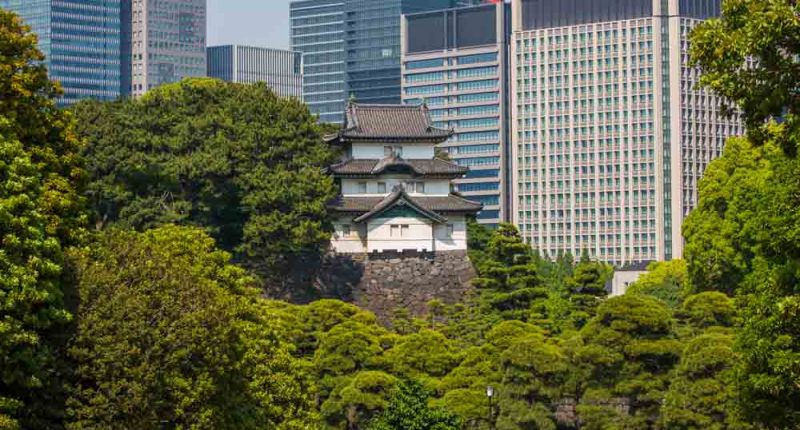
The Omiya Bonsai Art Museum
- Guided Tours
Share article
Signing up for a tour of Tokyo Imperial Palace is one of those things that I had been meaning to do for a long time, but figured I could do anytime so never actually bothered to register.
For those not already aware, Tokyo Imperial Palace is not generally open to members of the public. The closest tourists can usually get to the inner grounds is Seimonishi Bridge to take a picturesque photograph of the famous Nijubashi with Fushimi-Yagura Keep in the distance. There are only two occasions each year when the inner grounds are open to members of the public: 2 January for the New Year’s greeting and the Emperor’s birthday.
The Imperial Household Agency does, however, offer 75-minute tours of a limited section of the inner grounds. It used to be the case that you needed to reserve a place via the official website ; however, in a bid to accommodate the expected increase in tourism in the run up to the 2020 Olympics same-day registration has been possible since mid-2016.
So what of the tour itself? Well, as I mentioned, it is a very limited tour. It is entirely outside; you will not be able to enter any of the buildings in the grounds. The tour departs in groups of over 100 people with the guide taking you past several buildings, explaining a little about the history of each through a portable megaphone.
Given the number of people participating in the tour and the wide open spaces in which the guide gives his introductions, unless you’re at the front of the group you’re going to struggle to hear anything. Audio guides are available in Japanese, English, Chinese, Korean, French and Spanish and can be download to iOS and Android via this link . They do also provide a pamphlet (and a sheet of A4 with translations) that give a one or two sentence explanation about each building, but the tour itself is only conducted in Japanese.
The tour starts from an administrative building near Kikyo-mon Gate . There is a security check before you go through, but there are no restrictions on photographs during the tour so you feel free to take your camera equipment (they only ask you to refrain from large group portraits—presumably because setting up tripods and the whatnot would hold everyone else up). The tour takes you past the following main buildings:
Mt. Fuji View Keep
A 3-storey keep that has withstood much of what nature has thrown at it since its reconstruction in 1659. One of the oldest remnants of the former Edo Castle.
The Imperial Household Agency Building
Head office of the Imperial Household Agency was built in 1935. It was used as the home of the family for some years after the war as reconstruction took place on the Imperial Palace.
Kyuden Totei Plaza
Perhaps somewhat surprisingly, the Imperial Palace itself is—whilst an impressive structure—maybe not what many are expecting. The main building that faces the plaza is called Chowaden (長和殿) a 160-meter long structure with a 100-meter balcony.
The balcony is a lot lower than the television images and newspaper photographs have many believe. The guide explained that images of the imperial family greeting flag-waving visitors on the special occasions when the grounds are open to the general public are deliberately taken from a lower position to give an impression of the balcony being more raised.
Nijubashi & Fushimi-Yagura Keep
These two structures will be familiar to anyone who has visited the Imperial Palace: the ornate stone bridge and the white castle-type structure in the distance that must rank among Tokyo’s most photographed buildings. This is the highlight for many, and is also the turnaround point. The route back takes a slight detour down Yamashita-dori between the Imperial Palace and the Imperial Household Agency building, but is more or less the same as on the way.
Incidentally, the best photograph opportunity on the tour is on the way back as you walk past the small slope that leads to the main building of the palace. Stop here and you can see a beautiful view of Mount Fuji Keep surrounded by greenery with the office buildings of Otemachi in the distance.
The tour is free and, although limited, provides a good glimpse inside the Imperial Palace. The explanations definitely put the tour into a better context so be sure to download an audio guide before you depart, as the pamphlets only give the briefest of descriptions.
Information
You may also like.
- Entertainment
Robot Restaurant
Tokyo dome city, anata no warehouse.
-Wa- Japan Web Magazine

Detailed instructions on how to visit Tōkyō Imperial Palace
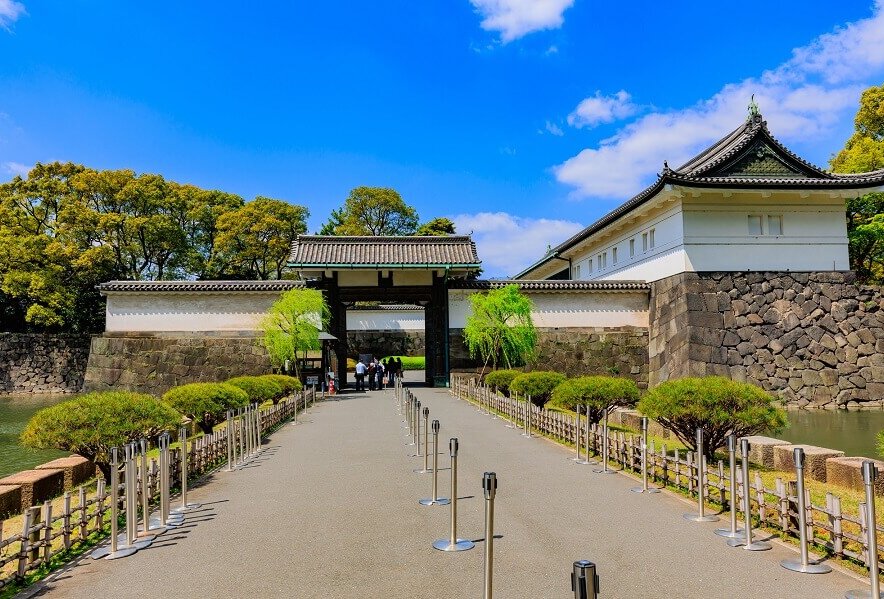
The Imperial Palace is one of the most popular tourist attractions in Tōkyō, Japan.
However, due to limited information about visiting the Royal Palace, it may be difficult for those who come to visit for the first time.
“When is the time to visit the Tōkyō Imperial Palace?” “What’s inside the Imperial Palace?” “Is it possible to see the Emperor just by visiting the Imperial Palace?”
And there are certainly many more questions.
In this article, I will detail how to visit the Tōkyō Imperial Palace so that even your first visit can easily navigate and choose the right schedule.
If you are planning to visit the Tōkyō Imperial Palace, make sure to take note of this information.
Can see The Emperor on 2 special visits at the Tokyo Imperial Palace
Introduction to tōkyō imperial palace.
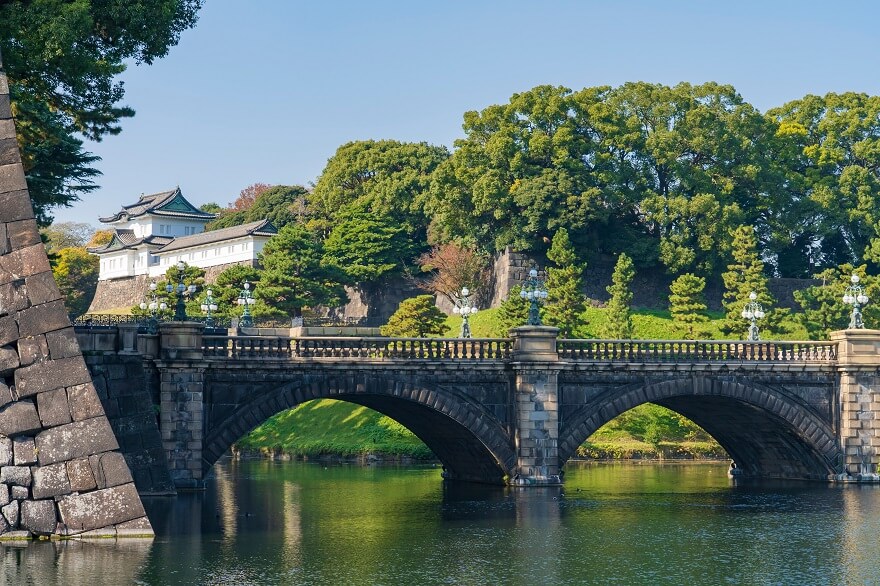
Tōkyō Imperial Palace in Japanese called Kōkyo (皇居), was the residence of successive Emperors from Emperor Meiji to the present Emperor.
The Imperial Palace is located in the heart of Tōkyō, just a 15-minute walk from Tōkyō Station. Surrounded by moats and vast gardens, the Tōkyō Imperial Palace has a dignified and tranquil atmosphere almost isolated from the bustling outside world.
Tōkyō Imperial Palace was originally Edo Castle – the former castle of the Tokugawa Shogunate government*. Therefore, visiting the inside of the Imperial Palace, you will be able to see some architectural remnants such as the foundation of Edo Castle, the gate, the watchtower…
(*) Note: The Tokugawa Shogunate was a powerful Samurai government that controlled the politics and economy of Japan from 1603 to 1867. In 1867, Shogun Tokugawa Yoshinobu officially handed power to the Emperor, ending the Edo era and ushering in the Meiji era.
Outline map of Tōkyō Imperial Palace
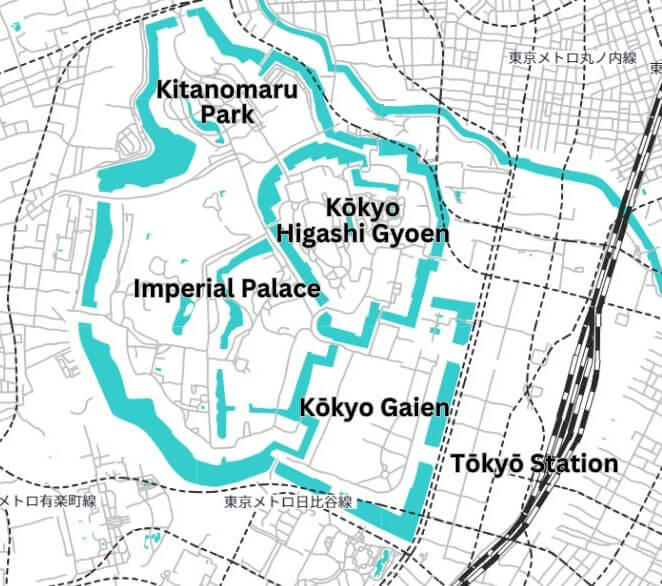
Tōkyō Imperial Palace has 4 main areas:
- The grounds inside the Imperial Palace
- National Park outside the Tōkyō Imperial Palace: Kōkyo Gaien
- Tōkyō Imperial Palace East Garden: Kōkyo Higashi Gyoen
- Tōkyō Imperial Palace North Park: Kitanomaru Kōen
Currently, all four areas above are open to visitors. In particular, if you are lucky enough to visit the Imperial Palace on January 2 and February 23, you can also see the Emperor and his family waving from afar.
In the next content, I will introduce in detail how to visit each area of the Tōkyō Imperial Palace. Make sure to refer to it to make your visit more convenient and enjoyable.
Tour the inside of the Tōkyō Imperial Palace
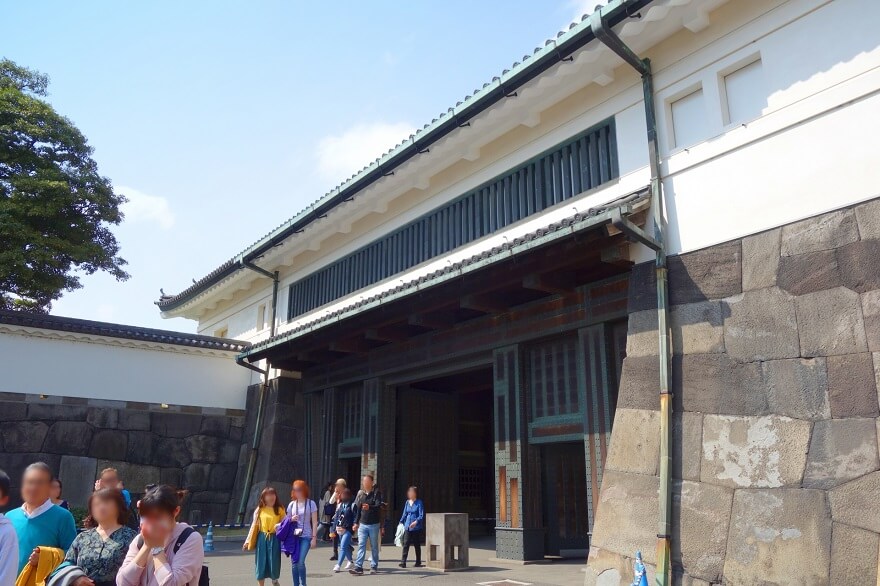
Admission conditions:
- Pre-registration is mandatory (see registration method below)
- Need to show proof such as driver’s license, My Number card, passport, residence card or insurance card… (original)
Ticket price: free
Visiting time: There are 2 tours per day, morning at 10:00, afternoon at 13:30. Each tour lasts about 75 minutes.
- Public Holidays (if it falls on a Saturday, it will still be open)
- Afternoon from July 21 to August 31
- December 28 ~ January 4 next year
- Days with events or maintenance problems
How to register: There are 3 ways to register, which is online registration, pre-registration by phone or directly to the Imperial Palace gate to get tickets on the day you want to visit.
1. Online registration: The registration portal will open from 5:00 am on the 1st of the month before the date you want to visit. For example, if you want to visit in June 2023, you can apply from May 1, 2023. Registration link: https://sankan.kunaicho.go.jp/register/month/1001?locale=ja
2. Pre-registration by phone: Sometimes even though online registration is full, there is still room for phone registration, so you can test call to confirm in person. Phone number: 03-5223-8071 (Available time: 8:45 ~ 12:00 or 13:00 ~ 17:00)
3. Go directly to the Imperial Palace gate to get admission tickets: Admission tickets are issued in front of Kikyō-mon Gate (桔梗門) at 9am (tickets for the tour start at 10am) and 12:30pm (tickets for the tour start at 13:30). Tickets are distributed in order of queue at that time and only 1 ticket per person is allowed.
Number of registrations:
- Register online or by phone: 200 people
- Come get tickets directly: 300 people
The journey takes about 75 minutes with the sightseeing route about 2.2km. A guide (Japanese, English, Chinese) will accompany you throughout the journey.
Meet up at the Kikyō-mon Gate Sōmeikan (rest area) Watchtower Fujimi Yagura Imperial Household Agency East Garden Nijūbashi Bridge Back to East Garden Yamashita-dōri Street Imperial Household Agency End of tour at the Kikyō-mon Gate
How to get to Kikyō-mon Gate:
- 10 minutes walk from Exit No.6 of Nijubashimae Station or Exit D2 of Otemachi Station
- 15 minutes walk from Tokyo Station’s Marunouchi Central Exit
Visit Kōkyo Gaien – the National park outside the Tōkyō Imperial Palace
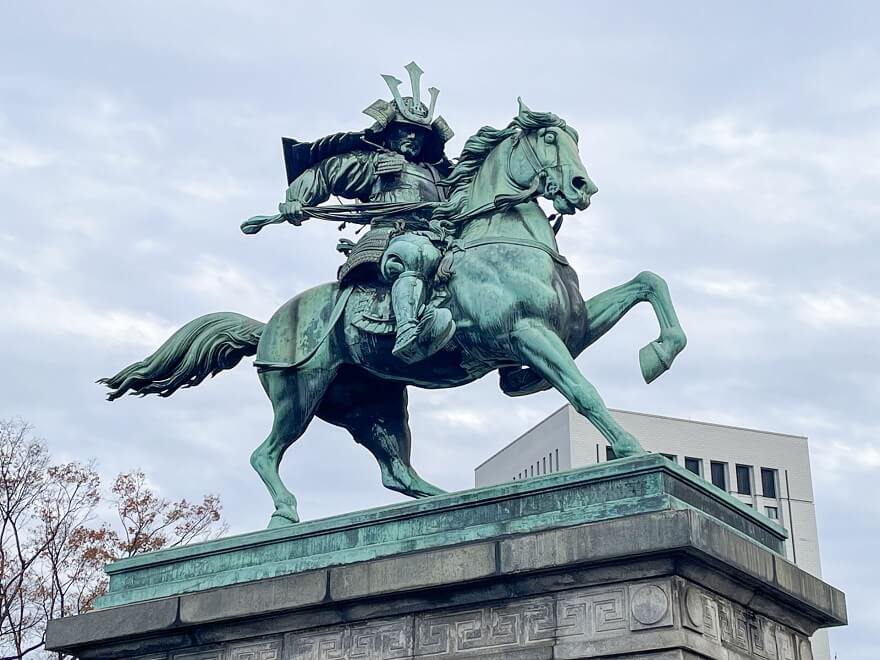
Japanese name: 皇居外苑 (Kōkyo Gaien)
Opening hours: 24/24 However, there may be restrictions on access when there are national events.
Some outstanding attractions:
- Nijūbashi Bridge (二重橋): the iron bridge located at the main gate of the Imperial Palace.
- Sakuradamon Gate (桜田門): the gate has been recognized as an Important Cultural Property of the nation.
- Bronze Statue of Kusunoki Masashige (楠木正成像): a 6.7 ton statue, 8 meters high (including the pedestal) donated by Sumitomo Corporation.
- Black pine forest (クロマツ): about 2,000 black pine trees are scattered on the large lawn, creating an airy and majestic scene.
- Wadakura Fountain Park (和田倉噴水公園): was built in 1961 to celebrate the marriage of the then Emperor and redeveloped in 1995 to celebrate the marriage of the Crown Prince.
- 2 minutes walk from Exit No.2 or Exit B6 of Nijubashimae Station (Tokyo Metro Chiyoda Line)
- 8 minutes walk from Exit No.3 of Sakuradamon Station (Tokyo Metro Yurakucho Line)
- 2 minutes walk from Exit No.2 or Exit B6 of Hibiya Station (Tokyo Metro Hibiya Line)
- 10 minutes walk from JR Tokyo or JR Yurakucho
Visit Kōkyo Higashi Gyoen – East Garden of Tōkyō Imperial Palace
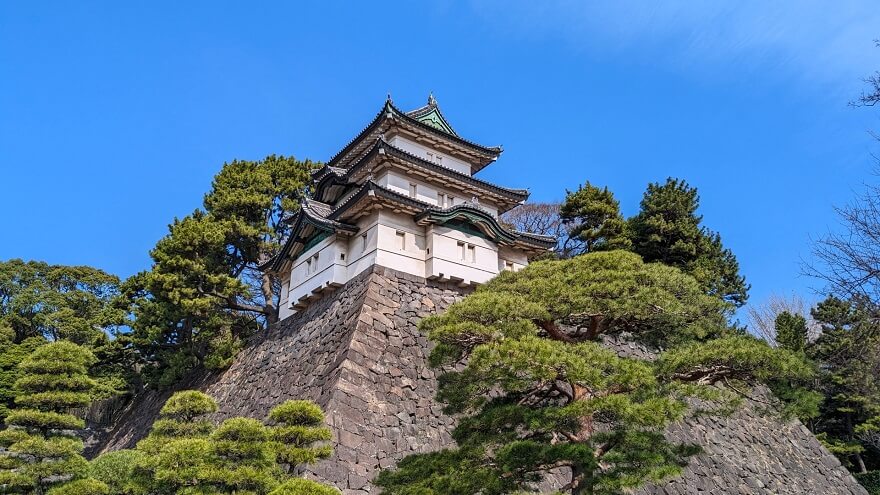
Japanese name: 皇居東御苑 (Kōkyo Higashi Gyoen)
Admission conditions: receive the entrance card when entering and return it when leaving the garden.
Opening hours:
- March 1 ~ April 14: open from 9am to 5pm (last entry is until 4:30pm)
- April 15 ~ end of August: open from 9am to 6pm (last entry is until 5:30pm)
- September 1 ~ end of September: open from 9am to 5pm (last entry is until 4:30pm)
- October 1 ~ end of October: open from 9am to 4:30pm (last entry is until 4pm)
- January 1 ~ end of February: open from 9am to 4pm (last entry is until 3:30pm)
- Monday and Friday However, if Monday or Friday coincides with a national holiday (except for the Emperor’s birthday), it is still open. If Monday is open, it will be closed on Tuesday.
- From December 28 to January 3 next year
- Dates with events or other force majeure reasons
- Ōte-mon Gate (大手門): the main gate of the old Edo Castle, destroyed in 1945 and rebuilt in 1967.
- Fujimi Yagura Watchtower (富士見櫓): 16m high tower, is the only 3-storey tower remaining in the Imperial Palace.
- Tenjudai ruins (天守台): the foundation of the old Edo Castle, 46m wide to the North and South, 42m to the East and West, 10m high.
- Kitahanebashi-mon Gate (北桔橋門): the gate that guarded the old castle. At that time, the bridge in front of the gate was designed so that it could be pulled up so that the enemy could not penetrate.
- Tōkagakudō Music Hall (桃華楽堂): built in 1966 to celebrate Empress Kōjun’s 60th birthday.
- Hirakawa-mon Gate (平川門): is the entrance of the women who worked in the old palace.
There are three gates to the Kōkyo Higashi Gyoen garden, namely the Ōte-mon Gate (大手門), the Hirakawa-mon Gate (平川門) and the Kitahanebashi-mon Gate (北桔橋門).
- 5 minutes walk from Exit C13a of Ōtemachi Station
- 10 minutes walk from Exit No.6 of Nijubashimae Station
- 15 minutes walk from Marunouchi North Exit of JR Tokyo Station
- 5 minutes walk from Exit 1a of Takebashi Station
Visit Kitanomaru Kōen – the park at north of Tokyo Imperial Palace
Japanese name: 北の丸公園 (Kitanomaru Kōen)
- Tayasu-mon Gate (田安門): built in 1636, is the oldest of the existing architectural ruins of the former Edo Castle.
- Shimizu-mon Gate (清水門): rebuilt in 1658.
- Shōwakan National Memorial Museum (昭和館): a place to keep historical documents about the difficult life of Japanese people during and after the war (circa 1935 to 1955).
- National Museum of Modern Art (東京国立近代美術館): is the first national art museum in Japan, which houses documents and artworks from the 19th century to the present.
- National Archives of Japan (国立公文書館): a place to preserve and store historical documents transferred from national administrative agencies.
- 5 minutes walk from Kudanshita Station
- 5 minutes walk from Takebashi Station
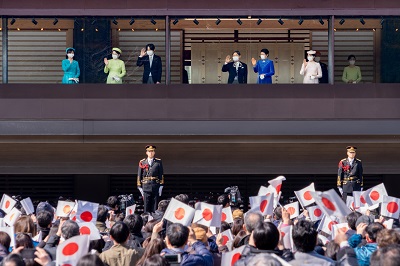
Every year, the Tōkyō Imperial Palace organizes 2 special visits on New Year’s Day (January 2) and the Emperor’s Birthday (February 23).
If you are lucky enough to participate, you will be able to see the Emperor and his family waving from the balcony in the distance.
Of course, not everyone can participate in this special tour, but you need to register (free) and win the lottery.
How to register will be announced on the official website of the Royal Household Agency about 2~3 months before the event. If you are interested, please check the website regularly.
- Details of the New Year’s Day Tour to Tokyo Imperial Palace (January 2): https://www.kunaicho.go.jp/event/sanga/sanga01.html
- Details of the visit to Tokyo Imperial Palace on the Emperor’s birthday (February 23): https://www.kunaicho.go.jp/event/sanga/sanga02.html
In the midst of the bustling and bustling capital Tokyo, the Imperial Palace is like a peaceful and beautiful oasis that gives you the feeling of being lost in another world.
Visiting the inside of the Tōkyō Imperial Palace is of course great, but if you can’t register, you can also stroll through Kōkyo Gaien National Park, Kōkyo Higashi Gyoen East Garden or Kitanomaru Kōen North Park.
Besides the beautiful scenery, each area of the Tōkyō Imperial Palace has historical sites that are sure to give you a deeper insight into Japanese history.
If you have the opportunity to visit Tokyo, you should definitely take the time to visit the Imperial Palace!
- Author: wasabi
Details of the blood donation process in Japan and blood donation locations
Detailed instructions on how to visit Sensoji Temple
- Writer's New Articles
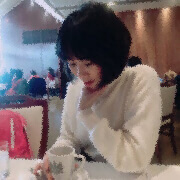
(Update 5/2024) Uber Eats Japan Promo Code for 3400 yen Off
Asakusa One-Day Travel Itinerary in Kimono
7 famous sightseeing spots in Kinugawa Onsen area
- 0 Trackbacks
There are no comment yet.
There are no trackback yet.
(Update 3/2024) Discount coupon of DEMAECAN
What is ikebana a thorough explanation of the characteristics and basic knowledge of ikebana, top 15 popularity rankings of japanese beer, happōshu and quasi-beer, top 20 tourist attractions in tokyo.

16 extremely cute animal cafes in Tokyo
18 best character cafes and restaurants in tokyo, how to enjoy tokyo tower, 7 nightlife spots in tokyo.

Food & Drinks
Destinations.

Tokyo Imperial Palace - Opening Hours, How To Get There, And What To Do
By gowithguide travel specialist: fidelia a..
Things To Do
When visiting Tokyo, I bet that you would want to take a peek of the Imperial Palace. However, you might not know when is it opened and what you can do there. Here in this article, I will discuss all the things you need to know about Tokyo Imperial Palace, including opening hours, hot to get there, and what to do when you arrive. Let's go!
About the Imperial Palace Area
The main area itself is not open for public. This is perhaps because the Imperial family themselves still lives in the premises. This is why the main area of the Imperial Palace is closed for public, except on two specific day of the year, which is January 2nd for New Year’s Greetings event and December 23rd which is the Emperor’s Birthday.
However, there are guided tours of the palace grounds offered regularly throughout the years. This tour though does not enter any building. The tour itself spanned for about 75 minutes but would be held in Japanese. Foreign visitors could take English audio headsets.
Prior bookings are required to join the guided tours of the palace grounds. You can book the tour via their website, filled in the form which is in English, or ask someone (hint: a guide !) to book one for you. I found some tours here which offers a walking tour around the Imperial Palace. If you still have questions or unsure feel free to send a tour request .
If you’re lucky, you could get same-day bookings if there are some spots available. Go to the Kikyomon Gate before the start of the tour of the day.
Imperial Palace East Garden
The Imperial Palace East Garden is located in the inner area of the Palace. They were part of the former Edo Castle, which was destroyed in a fire. Although none of the building still exists to this day, the moats, entrance gates, and walls are still there. Even several guardhouses still exist.
You can visit the Imperial Palace East Garden from Otemachi Subway Station within a 10 minutes walk. If you prefer to use the JR line, you can stop at Tokyo station and take a 10 to 15 minutes walk to the Imperial Palace Area.
What to do nearby
Chidorigafuchi park.
This park is popular, especially during the Sakura season. It is basically one of the 12 moats that surround the palace. In this particular moat, the river is lined with beautiful Sakura trees. Although there is no park around the moat, visitors could still enjoy a boat ride for a fee.
This place would be extremely crowded during the hanami (flower viewing) season. There are a few spots for picnic available, but it would be full in no time. If you want to enjoy a picnic in this area, you should come earlier and tag the best spot or send someone to get it first!
Kitanomaru Park
This is another one of the moats surrounding the Palace. Located in the north of the palace, this place used to be a military base before it was converted to a park in 1969. You can find Sakura trees in this moat too, and the plus point of Kitanomaru Park is that this place has more spots for picnics. This park is also quite well known for its Autumn leaves!
Marunouchi Area
The Marunouchi Area lies in close proximity from Tokyo station. It has long been established as a high-class area. This area is lined with skyscrapers and fancy shopping and dining areas. The Marunouchi Area is most famous during the winter season, as thousands of LED lights up the trees in Naka-dori street. This is a definite spot to stop-by for your sightseeing trip around Tokyo Imperial Palace!
Getting the right time to see the Imperial Palace might be difficult. As I mentioned before, you need prior reservations for the guide. However, this might be difficult if you are not used to Tokyo’s public transportation. You might miss your booking since you got lost somewhere down the road. Fear not! I have a way to get you out of this mess: Hire a private guide ! If you hire a private guide, you would be able to get reservations easier. Moreover, your guide could also provide ideas about where to go next from the Imperial Palace!
For those of you who are looking for a private guide, then I would recommend you to get one from GoWithGuide ! Not only that they have excellent guides that would cater to your every need, but they also offer you the best customer service as possible to make sure you’re in the right hands. If you want to include other destinations within your trip, check out all the other private tour groups that are available as well as other cultural activities available in Tokyo.
Blogs About Traveling To Tokyo
13 Top Tokyo Tourist Attractions by Local Guides
Tokyo Itinerary: Tokyo Up To 3 Days - First Timers
9 Best And Most Popular Tokyo Tours
Tour Guide In Tokyo: Pros And Cons To Hiring One
Tokyo New Toyosu Fish Market: Complete Guide Before You Visit
Popular Tokyo Tour Guides

My name is Shusaku. I was born and raised in Osaka, where I had the opportunity to immerse myself in the beautiful landscapes and rich culture of the region. During my travels to 10 different countries, I came to realize the importance of listening to the locals to truly understand the culture and charm of a place. This experience taught me that local knowledge and experiences are invaluable in building a deeper understanding and connection while traveling. In my tours, I make it a point to not only showcase the popular tourist destinations but also to share insights into the everyday lives of locals and the culture of the region. By incorporating stories and knowledge from locals, I aim to provide a more enriching travel experience. My mission in life is to foster a deeper understanding of the world through travel and to build connections with people from different backgrounds. I look forward to creating unforgettable memories and sharing new discoveries with all of you!
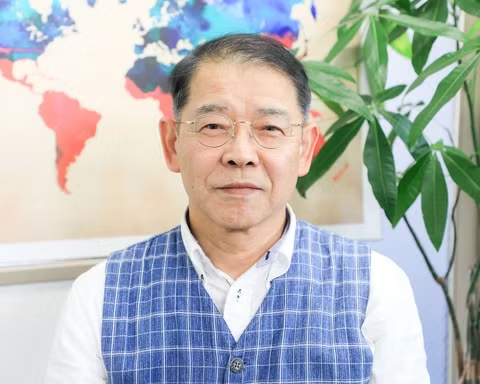
Hello, my name is Yasuro (Mr). I was born and brought up in Kansai, graduated from a univ in Kobe city, after moved into Kanto, 30 years in Tokyo, 2.5 years in Nagoya city, 7.5 years abroad (KL & S'pore) as a rep of a construction company and I got the National Guide Certificate in 2011. My hobbies are making Haiku poems, singing various songs (voice-training for 18 years), playing the folk-guitar, trekking in mountains like Takao and Okutama in the West of Tokyo, visiting museums like in Ueno Park and travelling around Japan to make Haiku poems. Thank you for your attention.
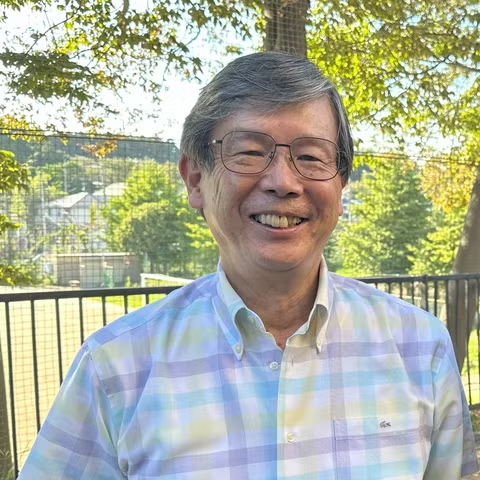
I’m so excited to have a chance to show you around my favorite spots in Kanagawa prefecture. I was born in Kanagawa. I spent my whole school life, including university, here in Kanagawa. I worked as a high school English teacher here for 40 years. I love Kanagawa so much. We have many interesting tourist spots, like Hakone, Kamakura, Enoshima and Yokohama. I got my tour guide license in English in 2009. I am still an English teacher. To give an interesting and impressive lesson to young high school students, I’ve learnt and gathered many kinds of information. I also have a license to teach social studies, so I have a wide range of knowledge about Japanese culture and history. I’m sure to provide you an interesting tour.

I live in Yokohama, Kanagawa prefecture. I have a license to teach in high schools and was admitted to the degree of Master of Arts in Teaching English as a Second Language in the University of Birmingham. Until 2015 I had been teaching English at public high schools in Kanagawa for 37 years. During that time, I had some experience of guiding students from overseas through sister-school relationship around Tokyo and Kanagawa. Therefore, I had good command of English with the TOEIC score of 935. As for a tour guide experience I earned the certificate of National Government Licensed Guide-Interpreter in English and since then I have guided tourists to the popular sites around Tokyo, Yokohama, Kamakura and Yokosuka. My guiding focuses on introducing not only Japanese historical and cultural backgrounds but also giving tourists some tips to travel Japan only by themselves, such as how to use trains and subways, find good restaurants, reserve tickets, buy survenier, and speak basic Japanese. In addition, my tour includes opportunities to experience Japanese culture like Zen meditation, ninja performance, visiting anime's location sites based on tourists' request. Besides, by means of my hobbies of writing English Haiku and Waka (traditional Japanese poems) and performing Rakugo (traditional Japanese funny story telling) in English, I can surely entertain tourists during the tour. My moto as a tour guide is let the tourists have a once-in-a-lifetime experience in Japan with my profound, intelligible and interestiog guiding.
Plan your trip to tokyo.
Chat with a local tour guide who can help organize your trip.
Related Blogs
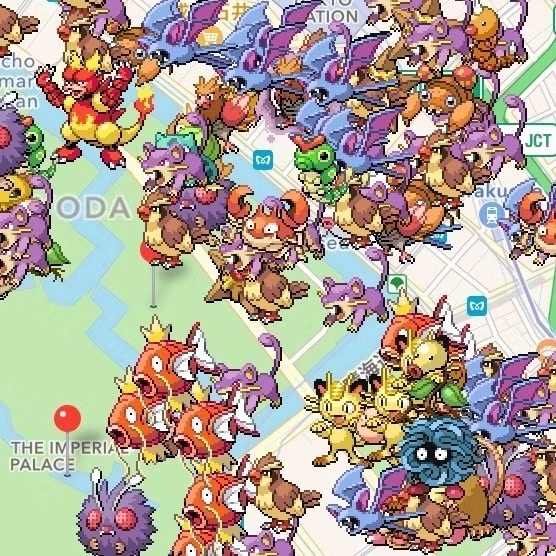
10 Best Places for Pokémon Go in Tokyo
Tokyo, Japan
⭐⭐⭐⭐⭐ Come & enjoy the beauty of Japan with our highly rated Japan private tours. LAST UPDATED: October 15, 2022 TLDR: The 10 best places for P...

Tokyo's Top 10 Sites for Anime and Manga Lovers
Tokyo, and in particular akihabara, has a plethora of museums, shops, cafes, and other sites targeted towards anime and manga lovers. as such, tokyo ....

10 Must-Go Shopping Destinations in Shibuya
Shibuya is a popular shopping district within tokyo where you can find a variety of places for entertainment and recreation such as shopping malls, re....

10 Best Onsen (Hot Springs) Around Tokyo
⭐⭐⭐⭐⭐ come & enjoy the beauty of japan with our highly rated japan private tours. last updated: october 15, 2022what is an "onsen"an "onsen" (温泉) is ..., follow us on social media.
Flow of Online Application
The application procedure varies according to the site to be visited and the number of visitors. Starting with Step 1, you will answer a series of questions to determine the application format appropriate to your request.

- About Privacy Policy
- About A Copyright
Imperial Palace East Gardens
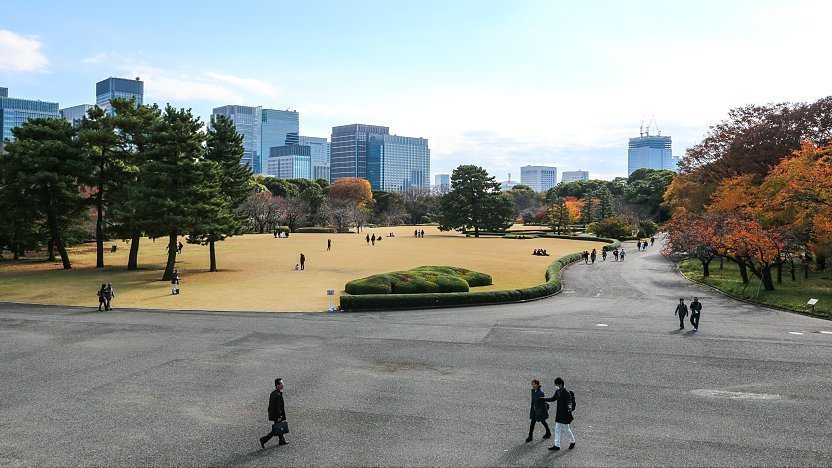
The Imperial Palace East Gardens (�c�����䉑, Kōkyo Higashi Gyoen) are part of the inner palace area and open to the public. They are the former site of Edo Castle's innermost circles of defense, the honmaru ("main circle") and ninomaru ("secondary circle"). None of the main buildings remain today, but the moats, walls, entrance gates and several guardhouses still exist.
Edo Castle was the residence of the Tokugawa shogun who ruled Japan from 1603 to 1867 . Emperor Meiji also resided there from 1868 to 1888 before moving to the newly constructed Imperial Palace .
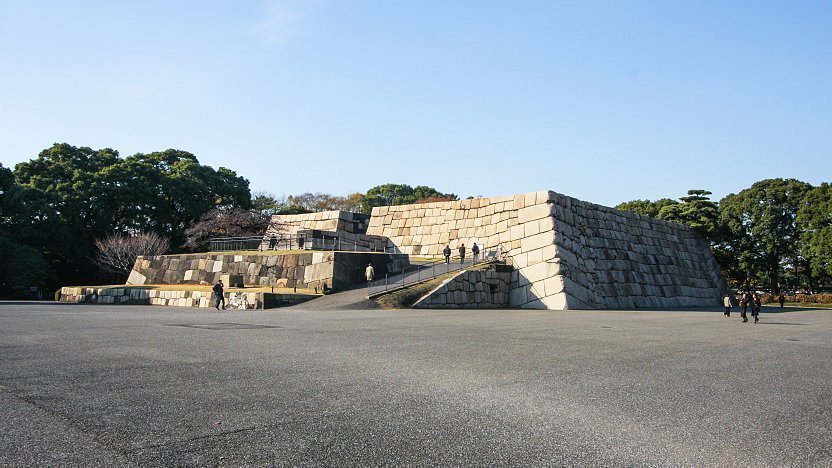
A wide lawn and the remaining foundation of the former castle tower can be found on top of the hill, where the castle's innermost buildings once stood. The castle tower was completed in 1638 as the tallest castle tower in Japan's history. But only a few years later in 1657, it was destroyed by citywide fires and has not been rebuilt since.
In place of the castle's former palace buildings in the secondary circle of defense (ninomaru) at the foot of the hill, a nice Japanese-style garden has been created.
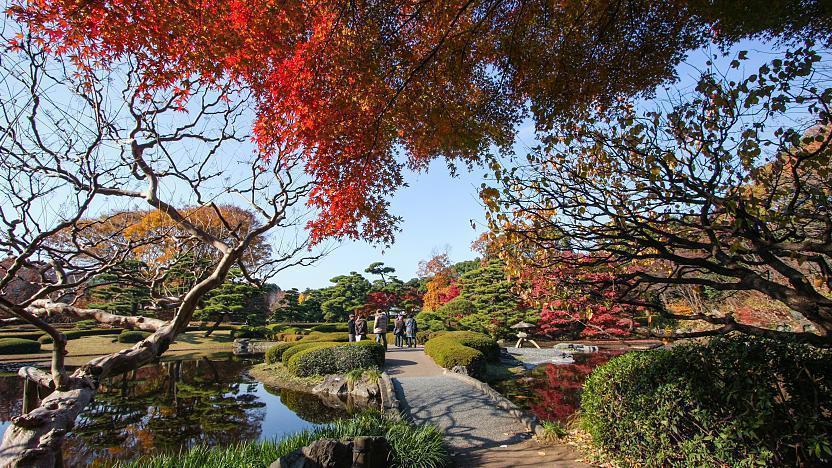
Getting there and around
The Otemon entrance to the East Gardens is a short walk from Otemachi Station on the Chiyoda, Tozai, Marunouchi, Hanzomon and Mita subway lines. It can also be reached in a 10-15 minute walk from Tokyo Station .
Orientation in Tokyo
Hours and Fees
Questions? Ask in our forum .
Links and Resources
Imperial household agency, closing day calendar, hotels around tokyo.

Experiences around Tokyo


IMAGES
VIDEO
COMMENTS
Various ceremonies and public activities are held there too. Other major buildings in the Palace include the building of the Imperial Household Agency and the Palace Sericulture Centre, where the successive Empresses have raised silkworms following the precedent set in 1871 by Empress Dowager Shoken, Empress and consort of Emperor Meiji.
Learn how to visit the Tokyo Imperial Palace, the residence of the Emperor of Japan, and see its gardens, bridges, gates, and ruins. Find out how to make reservations for the Inner Palace and explore its history and culture.
16,082 reviews. Home to Japan's Emperor, the Tokyo Imperial Palace occupies the site of the original Edo Castle (Edo-jō), the Tokugawa shogunate's castle, which was once the largest fortress in the world. Located in the center of Tokyo, the palace is surrounded by moats and serene gardens. Learn more. 1-1 Chiyoda, Chiyoda, Tokyo, 100-8111.
If you plan on joining the Imperial Palace tour, meet your guide at the Kikyomon Gate, a 10-minute walk from Nijubashimae Station or Otemachi Station. The center of the new capital For around 1000 years Kyoto was the capital of Japan, but in 1868 both the capital and Imperial Palace were moved to Tokyo after the Meiji Restoration.
Imperial Palace Walking Tour. Some part of the inner palace grounds can only be viewed on a tour, which is held in English and Japanese, twice daily, Tuesday thru Saturday. While same-day tickets are available, you can easily skip the queues by making an advance reservation for a ticket through contacting the Imperial Household Agency. The tour ...
Furthermore, guided tours of the palace grounds are offered during the rest of the year, although no buildings are entered. The tours take about 75 minutes and are held in English and Japanese daily at 10:00 and 13:30 except on Mondays, Sundays and national holidays.Advance reservations can be made through the Imperial Household Agency (see links below), but same-day registrations before the ...
1. Tokyo: Full-Day Sightseeing Bus Tour. Discover 18 Tokyo must-see places and activities on the deluxe coach in 1day. On this tour, be taken to the most famous places in Tokyo such as Meiji Shrine, Asakusa, and Imperial Palace. Enjoy popular activities such as going up to the 350-meter observatory at the Tokyo Sky Tree, drinking matcha, and ...
Tokyo: Imperial Palace History Walking Tour. 4.7 / 5 211 reviews. Activity provider: Sunrise Adventure. Add to wishlist. View all 22 images. 1 / 22. Join a local guide on a historic walking tour through the remains of the old-era Imperial Palace. Enjoy the peaceful East Gardens of the Imperial Palace while hearing about the development of Japan.
Discover all the highlights of the Imperial Palace with a national-licensed English-speaking guide. Travel back 400 years in time to the days of the Shogun up until the WWII restoration of the palace. Get to see Kokyo Gaien plaza, the vast East Gardens, and the Nijubashi and Meganebashi bridges. Learn more about the historical and cultural ...
The Imperial Palace. Guided Tour of the Imperial Palace (Free of charge) Generally conducted twice a day in the morning and in the afternoon. Prior Registration. Morning tour 9:00 am Numbered tickets will be distributed 9:30 am Registration starts 10:00 am Tour starts 11:15 am Tour ends. Afternoon tour
Overview. Price. From 14,080 ~. Our Rating. 4.6. This tour will take you around the Imperial Palace in Tokyo, a deeply historical site once home to Edo Castle, and where the Emperor and Empress of Japan reside today. It then moves onto nearby Nihonbashi, a bustling commercial district with stores that have been in business for over 400 years.
Rail Tours. from. $468.99. per group (up to 6) The area. 1-1 Chiyoda, Chiyoda 100-8111 Tokyo Prefecture. Neighborhood: Ginza / Tokyo Nihonbashi. Ginza is famous for being a trendy hotspot, but it's also a downtown area with shops that were founded over a hundred years ago. Department stores and luxury boutiques line the route from Nihonbashi to ...
FULL GUIDE to the Tokyo Imperial Palace: a wealth of gardens & galleries, with guided tours and castle ruins. With access, tour info, special dates & more. ... Tokyo Imperial Palace tours are free but require registration, either in advance online or on the day. Currently, only 120 guests are accepted each day (previously 500), with 70 spaces ...
16 March 2018. Since March 2018, the Imperial Household Agency organises free tours of the inner palace grounds in English. Previously this was only available in Japanese or you needed to download an app if you wanted to hear explanation in English. The tour takes you close to several buildings of the palace and former Edo Castle, while ...
Perhaps somewhat surprisingly, the Imperial Palace itself is—whilst an impressive structure—maybe not what many are expecting. The main building that faces the plaza is called Chowaden (長和殿) a 160-meter long structure with a 100-meter balcony. The balcony is a lot lower than the television images and newspaper photographs have many ...
2. Pre-registration by phone: Sometimes even though online registration is full, there is still room for phone registration, so you can test call to confirm in person. Phone number: 03-5223-8071. (Available time: 8:45 ~ 12:00 or 13:00 ~ 17:00) 3. Go directly to the Imperial Palace gate to get admission tickets:
You can visit the Imperial Palace East Garden from Otemachi Subway Station within a 10 minutes walk. If you prefer to use the JR line, you can stop at Tokyo station and take a 10 to 15 minutes walk to the Imperial Palace Area. Location. Imperial Palace East Garden (map) Schedule. 09.00 - 16.30.
the Facilities. Information ; The Imperial Palace. Information ; Kyoto/Kyoto Sento Imperial Palace,Katsura/Shugakuin Imperial Villa.
Flow of Online Application. The application procedure varies according to the site to be visited and the number of visitors. Starting with Step 1, you will answer a series of questions to determine the application format appropriate to your request. Select the Place. Select the place you wish to visit from the "Places" menu. >> Proceed to Step 2.
3.8 (1,706) #16 of 81 most visited in Tokyo. Intro. Get There. Hours & Fees. Hotels. Experiences. The Imperial Palace East Gardens (皇居東御苑, Kōkyo Higashi Gyoen) are part of the inner palace area and open to the public. They are the former site of Edo Castle's innermost circles of defense, the honmaru ("main circle") and ninomaru ...